






















Results of the re-assessment of the health impacts of the non-sugar sweetener (NSS) aspartame were released on 14 July 2023 by the International Agency for Research on Cancer (IARC), the World Health Organization (WHO) and the Food and Agriculture Organization (FAO) Joint Expert Committee on Food Additives (JECFA).
The re-evaluation assessment related to:
• the dietary intake assessment; and
• a systematic assessment of mechanistic data in context of overall carcinogenicity assessment.
Citing “limited evidence” for carcinogenicity in humans, IARC classified aspartame as possibly carcinogenic to humans (IARC Group 2B) and JECFA reaffirmed the acceptable daily intake of 40 mg/kg body weight.
Aspartame is an artificial (chemical) sweetener widely used in various food and beverage products since the 1980s, including diet drinks, chewing gum, gelatin, ice cream, dairy products such as yogurt, breakfast cereal, toothpaste and medications such as cough drops and chewable vitamins.
“The assessments of aspartame have indicated that, while safety is not a major concern at the doses which are commonly used, potential effects have been described that need to be investigated by more and better studies,” said Dr Francesco Branca, Director of the Department of Nutrition and Food Safety, WHO.
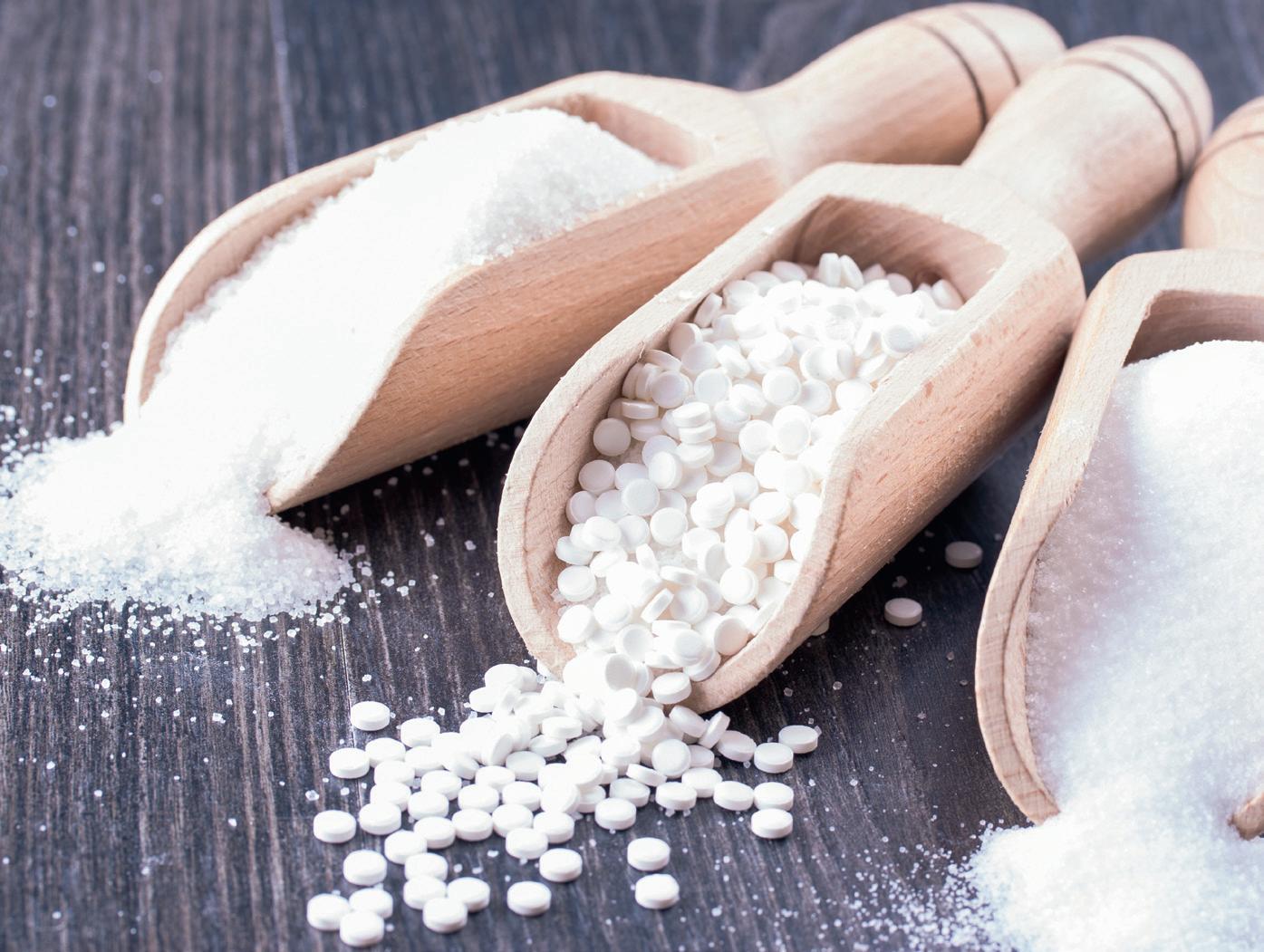
IARC and JECFA conducted independent but complementary reviews to assess the potential carcinogenic hazard and other health risks associated with aspartame consumption. This was the first time that IARC has evaluated aspartame and the third time for JECFA.
After reviewing the available scientific literature, both evaluations noted limitations in the available evidence for cancer (and other health effects).
IARC classified aspartame as possibly carcinogenic to humans (Group 2B) on the basis of limited evidence for cancer in humans (specifically, for hepatocellular carcinoma, which is a type of liver cancer). There was also limited evidence for cancer in experimental animals and limited evidence related to the possible mechanisms for causing cancer.
JECFA concluded that the data evaluated indicated no sufficient reason to change the previously established acceptable
daily intake (ADI) of 0–40 mg/kg body weight for aspartame. The committee therefore reaffirmed that it is safe for a person to consume within this limit per day. For example, with a can of diet soft drink containing 200 or 300 mg of aspartame, an adult weighing 70 kg would need to consume more than 9–14 cans per day to exceed the acceptable daily intake, assuming no other intake from other food sources.
IARC’s hazard identifications are the first fundamental step to understanding the carcinogenicity of an agent by identifying its specific properties and its potential to cause harm, ie, cancer. IARC classifications reflect the strength of scientific evidence as to whether an agent can cause cancer in humans, but they do not reflect the risk of developing cancer at a given exposure level. The IARC hazard evaluation considers all types of exposures (eg, dietary, occupational). The strengthof-evidence classification in Group 2B is the third highest level out of 4 levels, and it is generally used either when there is limited, but not convincing, evidence for cancer in humans or convincing evidence for cancer in experimental animals, but not both.
“The findings of limited evidence of carcinogenicity in humans and animals, and of limited mechanistic evidence on how carcinogenicity may occur, underscore the need for more research to refine our understanding on whether consumption of aspartame poses a carcinogenic hazard,” said Dr Mary Schubauer-Berigan of the IARC Monographs Programme.
IARC and WHO will continue to monitor new evidence and encourage independent research groups to develop further studies on the potential association between aspartame exposure and consumer health effects.
The Australian Beverages Council released a statement saying that it supports the use of non-sugar sweeteners (NSS) as a way for consumers to manage and reduce their intake of sugar from non-alcoholic drinks. The statement read: “Non-sugar sweeteners like aspartame are some of the most thoroughly tested food additives and undergo stringent testing by world-class food agencies like Food Standards Australia New Zealand (FSANZ), the US Food and Drug Administration (USFDA) and European Food Safety Authority (EFSA) before being declared safe for use in products.”
Compressed air production consumes a large amount of energy, which impacts a company’s bottom line as well as the environment.

However, there are some things businesses can do to immediately and sustainably make compressed air generation less expensive and more environmentfriendly.

This 10-step guide will help companies lower their energy consumption and carbon footprint, which
will translate into direct savings. In some cases, these savings will be substantial.
Best of all, while all of the 10 steps will save money in the long run, some of them cost very little to implement.
In fact, after you finish reading this guide you will be able to take meaningful action right away to make your production greener and more efficient.
Scan to download your FREE 10- step guide today!

Frucor Suntory’s new beverage manufacturing facility being built at Swanbank in Queensland will be powered by 11 GWh of renewable energy, thanks to an agreement signed with publicly owned CleanCo.

Expected to start operating in mid-2024, the multibeverage facility will include beverage processing, packaging, warehousing and distribution, with a capacity to produce 20 million cases of drinks annually.
“For over 120 years, Suntory has focused on Growing for Good, and we want our new $400+ million Swanbank facility to set a benchmark for sustainable investment for our global business and the FMCG sector,” said Darren Fullerton, CEO Frucor Suntory.
“Working with partners like CleanCo is essential to helping us achieve that vision and will allow us to operate with 100% green energy when the site goes live in mid-2024.”
Under the energy agreement, CleanCo will supply electricity and large-scale generation certificates (LGCs) covering 100% of Frucor’s electricity requirements.
The energy deal has been enabled by the Palaszczuk government’s investment of half a billion dollars to propel the development of up to 2.3 GW of large-scale solar and wind projects in regional Queensland.
Minister for Energy, Renewables and Hydrogen Mick de Brenni said: “Some of Australia’s favourite beverages will soon be manufactured using renewable energy produced right here in Queensland, with a deal enabling a state-of-the-art net zero manufacturing and distribution facility in Swanbank.
“It’s the Palaszczuk government that attracted Frucor Suntory to Queensland through our programs that support significant, job-creating private sector investment projects.
“Matched by our investments in renewable energy, we’re directly reducing embedded emissions in products manufactured in Queensland, meaning our industries remain highly competitive in the global marketplace and that equals job security,” Fullerton said.
Nestlé has introduced a sugar-reduction technology that can be applied across different product categories, which is claimed to have benefits beyond sugar reduction. It can also be used to produce low-lactose and skimmed milk-based products, while reducing total sugars.

Designed to reduce intrinsic sugar in ingredients such as malt, milk and fruit juices by up to 30%, the technology uses an enzymatic process that has a minimal impact on taste and texture. The sugarreduced ingredients are then used to create various products, without the need to add sweeteners or bulking agents to replace the volume of the eliminated sugar. When applied to milk-based products, the sugar reduction method also increases prebiotic fibres.
The technology was first piloted in cocoa and malt-based ready-todrink beverages in Southeast Asia and has been introduced in factory lines for powdered beverages such as Milo in several countries across Asia, Africa and Latin America. Since 2021, it has been applied to over 200,000 tonnes of cocoa and malt-based beverages. Other product categories such as dairy powders will follow.

TMX Global has completed the second of three distribution centres (DC) for Inghams Group, located in Edinburgh, South Australia.

The 15,380 m2 fridge and freezer facility sits adjacent to the poultry provider’s existing processing plant and will accommodate 100 staff.
The facility was designed under 5 Star Green Star guidelines for operational efficiency, in a collaboration between Inghams, TMX, Texco and Goodman.
Developed by Goodman and built by Texco, TMX Global managed the multidisciplinary project from end to end, providing DC design, technical scoping, property procurement and construction delivery management.
According to TMX Director, Sam Dellios, sourcing a site next to the processing plant will help to enable cost savings, transport efficiency and a reduction in the environmental impact.
The facility is also partly solar-powered, with 500 kW of solar installed on its roof and has efficient refrigeration systems installed to reduce electrical consumption by 50% in comparison to older plants.
Last year, the first facility opened in Truganina in Melbourne’s west. The third facility, in Hazelmere, Western Australia, will open later this year.
ifm started over 50 years ago as a sensor company that wanted to do things differently and make technology work for everybody. We’ve kept to this value and run our business as a family does – keeping close to our customers and focusing on a full solutions platform along with quality reliable products and customer service.


Our goal has always been to protect what’s important to our customers. This hasn’t changed. From paddock to plate, our automation technology has benefitted customers in the Australian food industry for many years.


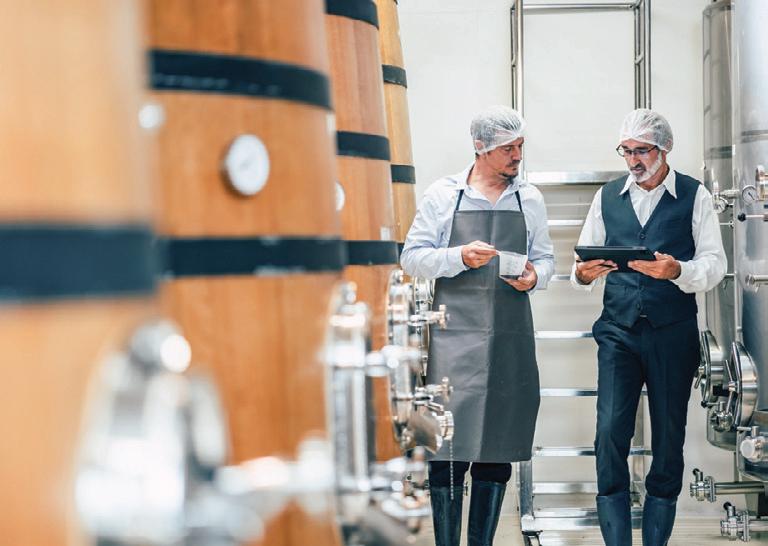


Talk with our team about how we can help to:

Jason Craig, an agribusiness leader with more than 25 years operating in all parts of the food supply chain, has been appointed as Managing Director of D’Orsogna Limited.
D’Orsogna is a family owned business headquartered in Perth. It produces and distributes cured and cooked whole and sliced hams, gourmet continental goods, bacon and cooked sausages. Its premises at Palmyra, near the port of Fremantle, has been D’Orsogna’s home since 1973 and remains its head office. The company also has a $65 million, 11,000 m2 food manufacturing facility in Victoria.
Prior to his new appointment as MD of D’Orsogna, Craig has headed CBH Marketing and Trading since 2012, a grain exporter with an annual turnover in excess of $2.5 billion via its activities in grain accumulation, trading, financing, shipping and distribution.

Tony Iannello, D’Orsogna Chairman, said the current Managing Director, Greig Smith, will work closely with Craig to ensure a smooth transition.
Asahi Beverages, the owner of Carlton & United Breweries, is powering the production of its drinks such as Great Northern, Victoria Bitter, Schweppes, Cool Ridge Water and Solo with energy supply arrangements linked to sunshine harvested in outback Queensland.
Flow Power brokered the power purchase agreement (PPA) for Asahi Beverages, accelerating it towards its goal of having 100% of its purchased electricity sourced from or matched with renewable sources by 2025.
Under the deal, Asahi will purchase 40,000 megawatt hours each year from a solar farm located in Clermont, Queensland. The 500-acre, single-axis solar tracking system farm at Clermont follows the sun’s trajectory for optimal energy generation, delivering a high per-unit energy yield. Clermont, which is owned by WIRSOL, makes use of Queensland’s existing grid infrastructure.
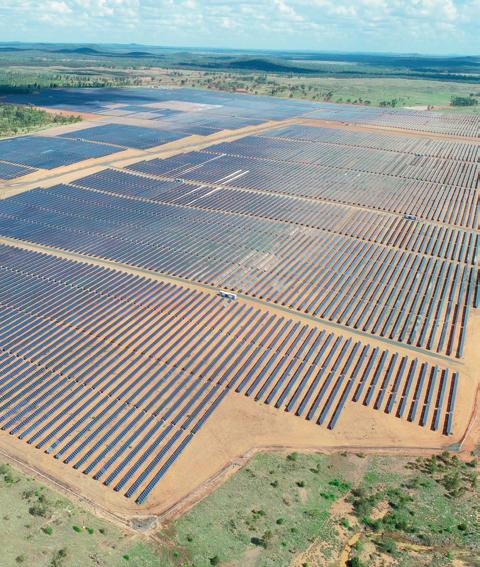
In July 2022, Flow Power secured an 8.5-year PPA for 25.22 MW from Clermont. This deal with Asahi Beverages accounts for around 80% of Flow Power’s offtake.
Asahi Beverages has obtained large-scale generation certificates (LGCs) from Flow Power as a result of the project and has also drawn significant energy from onsite solar panels at its Yatala brewery on the Gold Coast. This solar project generates enough solar power to brew the equivalent of around 150 million stubbies each year.
The PPA with Flow Power allows Asahi Beverages to continue to procure renewable energy, while also reducing purchasing costs and securing power supply over the long term.

Casella Family Brands has joined global collaborative program Sustainable Wine Roundtable (SWR) to work on advancing sustainability in the wine industry.
The company will provide support in driving global sustainability standards in the wine industry through collaboration, accountability and information-sharing between members.
SWR has over 90 members, acting as an independent collaborative platform to advance sustainability across the wine industry from production through to retail. It is creating a sustainability reference standard and developing tools that improve vineyard chemistry, labour standards, packaging, bottle weight and low carbon logistics.

Libby Nutt, Global Marketing and Export Sales Manager of Casella Family Brands, said, “Casella Family Brands is thrilled to join the Sustainable Wine Roundtable and further our activities to address sustainability issues in the wine industry.
“We are proud to be working with members who share a similar vision in preserving the natural environment, respecting human rights and generating a passion to better the industry.”
Sarah Bräude, Casella Family Brands Sustainability Manager, said that working collaboratively will lead to more opportunities for sustainability in the wine sector.
Cargill has invested $73m to upgrade and expand its Newcastle, Narrabri and Footscray oilseed crush facilities. This will help the company cater to rising demand for canola and cottonseed products and provide farmers with further access to global markets.
For its use across food products, biodiesel and as a feed stock, Australian canola is in high demand globally. Cargill, a supplier of high-grade canola oil to customers in Australia and Asia, has invested to expand its crush capacity and increase production.
This includes an upgrade and restart of Cargill’s Narrabri plant which has been modified into a cottonseed dehulling plant. The hulls will cater to domestic feedstock markets and cottonseed meats will be transported to Newcastle for further processing into oil and meal.
The Newcastle plant is also being upgraded to enable the crush of cotton seed, along with the existing processing capacity of canola. The upgrade will also include improvements in oilseed processing equipment, higher transport efficiencies and improving farmer delivery experience.
Cargill’s Footscray plant will also see an increase in canola crush capacity with processing equipment upgrades and modifications to drive logistical efficiencies.
The major export destinations for canola oil are China, Vietnam and New Zealand. This investment is expected to increase supply for domestic customers and support almost 100 jobs across three facilities.


Of the 2 million tonnes of wine grapes crushed annually in Australia, about 20% by weight remain as waste after processing. The majority of this winemaking waste, which includes skins, seeds and stalks, is currently returned to the land as compost, or other low-value applications.
Now, chemical engineers at Monash University have found that this waste from winemaking could be upcycled as a valuable source of ingredients for nutraceuticals, pharmaceuticals and food colouring. It could also have potential uses as functional ingredients in non-alcoholic beverages in the future.
PhD student Xueqing (Rachel) Liu and Associate Professor Victoria Haritos, Monash University Department of Chemical and Biological Engineering, found that compounds derived from red wine grape varieties have significant levels of bioactive natural compounds called polyphenols and anthocyanins.
Anthocyanins, the pigments responsible for the colours red, purple and blue in many fruits and vegetables, have also been associated with antioxidant effects. Both polyphenols and anthocyanins have also been associated with some health benefits.
“Bioactive polyphenols and anthocyanins could have a number of commercial applications as functional ingredients, in dietary supplements and as natural food colourings,” Liu explained.
The initial research, published in the international journal Cleaner Waste Systems, was supported by Treasury Wine Estates in collaboration with Coldstream Hills Winery in Victoria’s Yarra Valley where the winemaking samples were gathered.
In the next phase of the research, Liu will further investigate processes for extracting the bioactive compounds and their potential uses including functional non-alcoholic beverages.

Peter Simpson from the Manildra Group has been awarded the Alfred Stauder Award for Excellence, which recognises lifetime service to the confectionery industry in Australasia.
Amcor announced in May that it has signed a definitive agreement to acquire Moda Systems, a manufacturer of automated protein packaging machines.
Based in New Zealand, privately held Moda Systems designs, assembles and supports modular vacuum packaging solutions for the meat, poultry and dairy industries. The acquisition will complement Amcor’s existing strength in film, allowing it to offer an end-to-end packaging solution that encompasses primary packaging, equipment, on-site technical service and parts.
“This acquisition will enable Amcor to offer an exciting new option and choice in automated protein packaging, making us the only flexible packaging manufacturer to own a high-speed, rotary equipment solution for fresh meat,” said Amcor Flexibles North America (AFNA) President Fred Stephan.
Moda’s rotary vacuum system is designed to improve operational efficiencies for protein producers, enabling them to optimise labour, improve safety and reduce waste.

The automation technology will enable Amcor to provide a range of customisable format solutions beyond a standard shrink bag for the protein sector.

In Australia, Upfield is entering into a new area by extending its FLORA brand into the retail cream category.
More commonly known for its range of spreads, the brand’s thickened plant cream is designed to pour, whip and cook just like dairy cream.
Currently, most of the plant-based creams on the market use coconut and oat as their base, imparting an underlying flavour to dishes.
Made from lentils, the FLORA thickened plant cream is said to have a clean, neutral taste, and is 100% plant-based, palm oil free and vegan.
The award was presented in Melbourne at the recent ConTech 2023, which is the Ai Group Confectionery Sector’s annual event for the Australian confectionery industry.
“This is a wonderful, but very unexpected honour that the industry has given to me. I know that the past awardees have been very highly thought-of in the industry and to be included amongst those people is certainly an honour and a privilege,” Simpson said.
Simpson has been involved with the confectionery industry for over 40 years and is well deserving of the recognition, according to the presenter of the award — Tim Piper, Head of the Confectionery Sector for the Ai Group.

According to Piper, Simpson has been involved in forging new opportunities for confectioners in Australia, New Zealand and globally. He has also been involved in the administration of the sector and has played roles in managing and supporting the industry’s annual conferences.
“Simmo is a thoroughly deserving winner and this accolade is due acknowledgement of his significant contribution and value to the industry. He and Manildra have been great partners with the Australian confectionery industry,” Piper said.


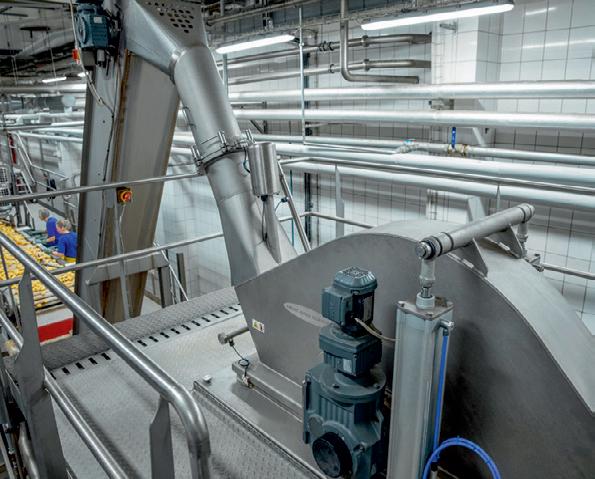






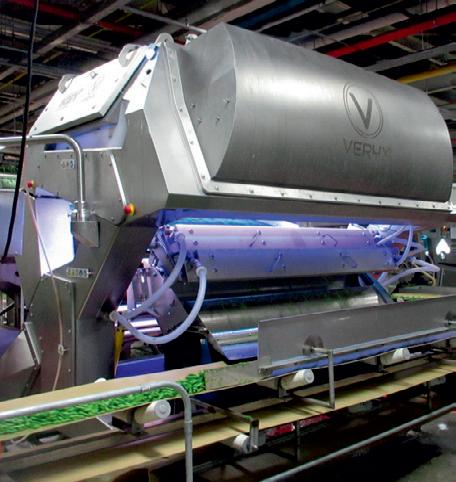

Aproject designed to further the adoption of traceability in the Australian egg industry has concluded. Commencing in 2020, the project was undertaken by Australian Eggs and involved the creation and extension of resources to help farmers implement on-farm traceability systems to suit their businesses. It has been supported by a Commonwealth grant designed to improve traceability across the Australian egg industry.
Traceability enables farmers to identify the sources of egg quality, safety or hen health issues and take steps to rectify the issues, to help ensure a safer egg supply chain.
“Traceability is no longer a ‘nice-to-have’,” said Rowan McMonnies, Managing Director, Australian Eggs. “Governments are prioritising it, consumers are expecting it and those businesses that focus on it are the ones that gain the most.”
The development of the EggTrace digital tool has headlined the project’s activities. This free tool enables all egg farmers to have access to the tools and technology required to trace eggs from lay to dispatch.
A comprehensive traceability manual has also been developed and made available to egg farmers. It outlines best practice for tracking eggs and provides advice and guidance to support the design of reliable traceability systems for egg farms.
Australian egg farmers agree that traceability is missioncritical for the egg industry.

Kate Daley, CEO of Pure Foods Eggs, said egg traceability is vital and investing and it is investing in the health and safety of people consuming the eggs.
“All egg farmers must maintain a state of readiness to trace and recall our products if needed to minimise potential harm to consumers," Daley said.
Denyel Cucinotta from LT’s Eggs in Victoria said, “Our traceability system makes sure we’re always working to the best of our ability; when problems arise, we can immediately execute a step-by-step procedure to investigate.
“If there is a food safety concern, we are able to make a quick search through our app and assess the problem, match codes and compare our data to the problem at hand."
According to McMonnies, traceability will continue to be a focus for Australian Eggs.
“We will continue to provide extension services to Australian egg farms looking to adopt new traceability protocols, and through consultation with industry we will continue to evolve EggTrace to ensure it has the highest level of utility for the industry,” he said.
Farmers can access all the tools via the Australia Eggs Traceability Hub.


In online retail, counterfeits of high-quality products, including food and beverages, circulate in large numbers. To combat this, scientists are developing a counterfeit-proof barcode system for authenticity verification that uses a smartphone without the need to access a database. The solution was presented at interpack.
The SmartID project has been developed by scientists at the Fraunhofer Institutes for Applied Polymer Research IAP, Secure Information Technology SIT and Open Communication Systems.
It takes advantage of the fact that every package possesses a unique, characteristic surface texture, comparable to a human fingerprint. This texture can be detected by smartphone cameras, which will scan the printed barcode and the texture of the surface. The barcode already contains information about the texture. A specially developed app compares whether the information stored in the barcode matches the data from the scanned surface.
The SmartID labelling system not only authenticates products, but may also contain additional information about them. The system is also easy to integrate into commercial printing processes during the manufacture of the packaging.
“With the SmartID technology, everyone in the supply chain — from the manufacturer to the intermediary and customs to the end consumer — will be able to check with a smartphone app whether a product bearing the SmartID code is genuine. The special thing here is that the app operates offline, ie, without access to a database and without a connection to
the internet,” said Tobias Jochum, coordinator of the project at the Fraunhofer Center for Applied Nanotechnology CAN in Hamburg.
For manufacturers, there is another advantage because there is no need to use a central database, eliminating various IT security and data protection challenges.
Konrad Öchsner, Innovation Manager at Koenig & Bauer Coding and new advisory board member of the SmartID consortium, said, “The complexity of the IT infrastructure can be significantly reduced by SmartID. Moreover, by avoiding the operation of databases or blockchain applications, no additional carbon dioxide is released, thus reducing the carbon footprint.”
The Fraunhofer consortium presented its first SmartID demonstrator at the stand of the German Engineering Federation VDMA as part of interpack 2023.
“An important requirement for SmartID barcodes is that they occupy as small an area as possible,” Jochum said. “As the project progresses, we are therefore optimising the system in terms of its required area and also its sensitivity. In this context, quantum materials play a key role. They enable significantly more features of the surface texture to be detected on a smaller area.”



SEE, formerly Sealed Air, and ExxonMobil have announced an advanced recycling initiative collaboration for foodgrade plastics. SEE Australia will introduce CRYOVAC preformed food packaging trays containing resins using ExxonMobil’s Exxtend technology for advanced recycling and mass balance attribution. This collaboration is set to divert approximately 900 tonnes of plastic waste annually from landfill or incineration.
As one of the first such initiatives for fresh red meat trays in Australia, the collaboration addresses the critical challenge in driving a circular economy for foodgrade plastics that have strict hygiene and performance requirements for food protection and distribution.
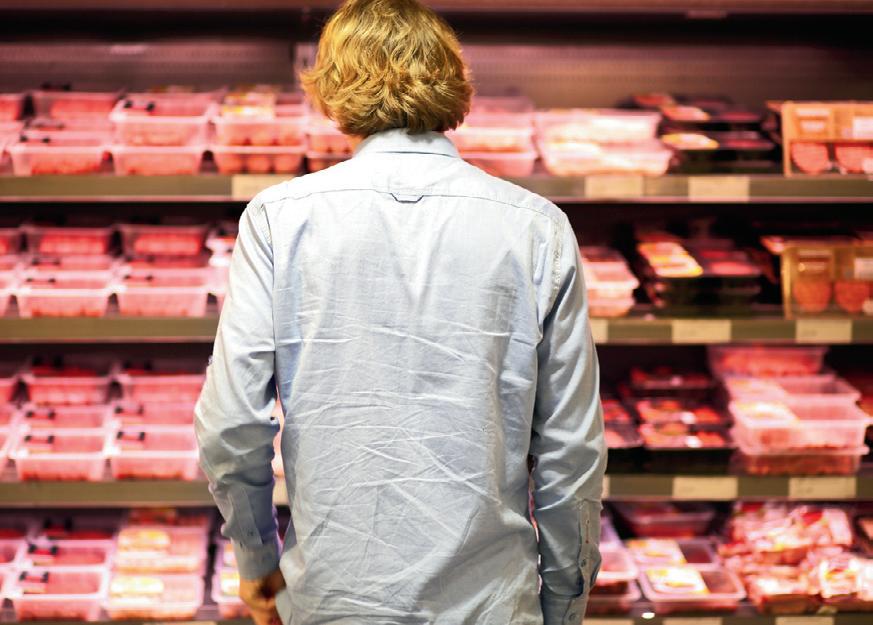
In this project, SEE Australia will start introducing the circular trays to the Australian market with the intention to move its entire Australian-made tray portfolio to the new solution over time. The resins and tray manufacturing are certified to the International Sustainability and Carbon Certification (ISCC) PLUS standard and the circular trays are curbside recyclable within Australia.
“We are delighted to work with SEE on this important project and excited that our ISCC PLUS certified-circular plastics leveraging Exxtend technology and mass balance attribution will play an important role in helping to address a challenge facing the food industry,” said Kwee-Lin Chan, General Manager, Asia Pacific Advanced Recycling and Sustainability for ExxonMobil. “This partnership marks an important milestone for certified-circular resins to be used to produce tray packaging solutions for retail. It’s a significant extension of our collaboration with SEE and helps demonstrate the importance of value chain collaboration to support the circular plastic economy.”
“This partnership opens up new possibilities in recycling high-performance materials,” said Alessandra Faccin, President of SEE Asia Pacific. “For SEE, it puts us closer to achieving our 2025 sustainability and materials pledge. Collaboration with our partners is key to drive the adoption of a circular business model, and this is exactly what we’re doing with Exx
Amcor Rigid Packaging (ARP) has partnered with Ron Rubin Winery for the launch of BLUE BIN, a premium wine packaged in a 750 mL bottle made from 100% recycled polyethylene terephthalate (rPET) plastic.

Ron Rubin Winery conducted a two-year assessment of wine packaging to develop a premium but environmentally friendly wine. The bottle features Plasmax technology, a thin glass layer preventing the wine from touching the rPET, protecting the taste and quality.
“Plasmax is a thin, glass-like oxygen barrier on the inside of the bottle. This protective barrier holds the wine, while the PET bottle holds the shape,” said Jonathan Jarman, Amcor Rigid Packaging marketing manager for spirits and wine.
Ron Rubin Winery is a SIP-Certified (Sustainability in Practice) brand, Certified California Sustainable Vineyard & Winery and one of 33 Certified B Corporation wineries in the world.
BLUE BIN is available now in four 2022 vintage varietals: Vin Rosé, Pinot Grigio, Chardonnay and Sauvignon Blanc.
The Boxed Beverage Company has partnered with food and beverage packaging company Tetra Pak to launch Waterbox, a sustainably packaged alkaline water sourced directly from Cottonwood Springs in Victoria.

Packaged in Tetra Pak’s plant-based carton bottle, Waterbox is claimed to have up to eight times less impact on climate change than traditional PET (polyethylene terephthalate) bottled water across its lifecycle in Australia and New Zealand. Where available, it can be recycled at kerbside collection points, where they can be transported to a saveBOARD recycling facility and turned into sustainable building materials for homes and offices.
The product comes as a response to growing demand in Australia for sustainably packaged and locally sourced products with a lower environmental impact.
Ohio State University researchers using eye-tracking technology found that 50% of study participants declared their intent to throw away milk based on the date stamped on the container — without even looking at the wording.

Food is wasted throughout the production process, but most of it happens at the consumer level. Misinterpretation of the date labels on foods is a common factor that can lead to wastage at this level.
The researchers chose milk for the study because it is widely consumed and represents about 12% of all food wasted by US consumers.
Each participant saw one of three phrasing options: ‘Sell by’, ‘Best if used by’ or ‘Use by’ a given date, as well as containers with no label at all.
“We asked them if they intended to discard it, and if they said yes, it didn’t matter which phrase was there,” said senior study author Brian Roe, professor of agricultural, environment and development economics at The Ohio State University.
“As soon as we changed the printed date, that was a huge mover of whether or not they would discard or not. So we documented both where their eyes were and what they said was going to happen. And in both cases, it’s all about the date, and the phrase is second fiddle.”
Some suggested solutions to this date labelling issue have been to establish best practice guidelines for setting dates and location of the label. Also phrasing could be improved to include words like ‘freeze before’ or even removing ‘best before’ labels altogether for non-perishable foods for which safety is not a concern.
According to Roe, US policymakers and industry leaders are now working towards settling on a universal two-phrase system — one when quality, but not safety, is the concern, and a second phrase for items where safety may be a concern. However, they haven’t released any standard phrases yet.
“If you’re going to have an education campaign, it helps to have a set of phrases out there that people can cling to — but in the end, so few actually look at the phrase. They look at the date,” Roe said.
Data from eye-tracking technology showed that overall, participants spent more time fixing their eyes on the date compared to the phrase, looked at the date more frequently and laid their eyes on the date 44% faster than on the phrase.
“The date signifies a point after which you can expect quality to degrade. If you can get firms to push that date further out, then people are going to be willing to use the milk, or whatever it is, for a few more days, and waste a lot less food,” Roe said.
Though the quality of the milk affected participants’ intent to throw it away — with souring milk having about a third higher discard probability than fresher milk — the quality factor did not influence what participants spent the most time looking at on the label.
“The milk was intentionally made to smell a bit sour, and it didn’t really fundamentally change the fact that people really focus on the date,” Roe said.
The finding aligned with previous studies led by Roe in which the intention to throw away food was driven by the label date and not the phrase.
“For policy reasons, it’s still important to narrow the phrases down to two choices. But that’s only the beginning — there needs to be a broader conversation about pushing those date horizons back to help minimise food waste,” Roe concluded.
The study was published recently in the journal Waste Management
Turkish flavour company Aromsa was faced with a sustainability challenge when starting to work with a new customer who wanted to use stainless steel containers for shipping. This would have been a costly packaging solution requiring approximately 250 stainless steel containers as well as additional logistical costs of storage, maintenance, washing and sterilising the containers. Searching for an alternative solution, the company turned to Mondi Group and trialled the TankerBox on its production line.
The TankerBox is produced from corrugated cardboard and developed as a substitute for the traditional intermediate bulk container (IBC) and metal barrel. Its design consists of five parts: an outer box, inner octabin, angle frame, bottom star and top cover pieces. The system has two alternative design options for discharging either from the top or bottom and is structured to minimise residual contents in the product.

Nil Okyar, Production Manager at Aromsa, said the TankerBox can fulfil all the operations the stainless steel container was fulfilling. It also simplifies transportation and helps avoid the return event associated with metal containers. It can also be stacked, gaining storage space and doubling shipping capacity.
In comparison to its metal drum or IBC equivalents, the TankerBox’s design can create cost advantages from efficiencies in storage and logistics as it does not need to be chemically
cleaned or returned as empty cargo. Additional benefits include easy handling and integration into filling lines as well as printability for brand enhancement.
The solution can be used in various industries, including chemistry, paint, pharmaceuticals and oil, as well as in the food industry for concentrated beverages, industrial liquid food and additives, alcoholic drinks, milk and dairy products. Mondi Group www.mondigroup.com/en/home/
Leibinger IQJET is used for the direct coding and marking of products and packaging. Suitable for the food and consumer goods sectors (FMCG), it also has applications in the industrial sector.

The plug and print solution is equipped with four assistance systems.
The SMART.OS operating system has a large 10 ″ touch display and numerous interfaces, including OPC UA and an integrated PLC, which are designed to ensure easy integration into the production line.
IQPRINT technology is designed to help ensure print quality. When not in use, the entire ink circuit, including the print nozzle, is sealed airtight and the ink continues to circulate. Thanks to this technology, regular maintenance and printhead cleaning routines can be eliminated, which can increase productive time.
The SMART.EFFICIENCY assistance system is designed to keep operating costs to a minimum, with a consumption rate of ~2.7 cc/h for MEK inks. Ink cartridges can be emptied down to the last drop and do not require separate disposal.
Thanks to the SMART.CARE function, maintenance is virtually eliminated. Requiring no scheduled maintenance for five years, the system’s operating costs are claimed to be as much as 30% lower than conventional systems.
Result Group
www.resultgroup.com.au
The Rosemount CT4215 is an inline system that tests food and beverage product packages going through production lines to provide seal integrity. This system measures up to 200 packs/ min, detects trace gases from defective packs and instantly rejects them without disrupting production.

Engineered with patented Quantum Cascade Laser (QCL) technology and designed with a small footprint, it is easy to install and configure and offers low maintenance costs. The QCL technology detects leaks at a sensitivity of <0.3 mm. Its software features full data logging capability that monitors production data. For increased system capabilities, its flexible modular design can be upgraded with additional lasers or sample heads.
Emerson
Automation Solutionswww.emerson.com/au/automation



With animalbased food products often coming packaged with a wide array of information labels, such as organic, natural, grass-fed, humanely raised and pastureraised, there is some confusion about food labels related to animal welfare.
Marisa Erasmus, associate professor of animal sciences at Purdue University, said consumers are typically left to try to figure out what these labels mean in order to choose products that align with their personal and social values.
In June this year, the U.S. Department of Agriculture (USDA) announced that it is implementing a multi-step effort aimed at strengthening the substantiation of animal-raising claims. This action builds on the work USDA has already undertaken to protect US consumers from false and misleading labels.
The Purdue researchers are now watching to see what additional documentation animal food producers may be required to provide regarding food label claims.
In general, US producers need to submit claims about their food products to the USDA’s Food Safety and Inspection Service (FSIS) for approval. The FSIS regulates food labels and claims on meat and poultry products. Some claims require that producers submit documentation before approval is granted.
Animal-raising claims, such as “grass-fed” and “free-range”, are voluntary marketing claims that highlight certain aspects of how the source animals for meat and poultry products are raised. In the US, these claims must be approved by USDA’s Food Safety and Inspection Service (FSIS) before they can be included on the labels of meat and poultry products sold to consumers. FSIS most recently updated its guideline on these claims in 2019.

The FSIS has received several comments from a wide range of stakeholders asking it to re-evaluate its oversight of animal-raising claims, specifically, how they are substantiated. In addition, the veracity of “negative” antibiotics claims (eg, “raised without antibiotics” or “no antibiotics ever”) has come into question.
According to Erasmus, one point of confusion is which claims are associated with animal welfare certification organisations that use third-party verification. “Producers that work with
one of these organisations can put the latter’s seal on their products to indicate that the animals were raised according to certain standards. Typically, those standards are intended to offer higher animal welfare than what you would see with a conventional product. But a lot of consumers don’t necessarily know what these different seals mean. And the absence of a label claim does not mean that food animals were raised inhumanely.”
FSIS will be issuing a revised industry guideline to recommend that companies strengthen the documentation they submit to the agency to substantiate animal-raising claims. The agency plans to strongly encourage use of third-party certification to verify these claims.
Another claim that can cause confusion is the idea of “no antibiotics added”, which may be misleading because antibiotics are occasionally used to treat live animals, not added to meat products. If animals are given antibiotics, there is a mandatory withdrawal period allowing the antibiotics to pass through the animal’s system before any products are created from that animal.
FSIS, in partnership with USDA’s Agricultural Research Service (ARS), will be conducting a sampling project to assess antibiotic residues in cattle destined for the “raised without antibiotics” market. The results of this project will help inform whether FSIS should require that laboratory testing results be submitted for the “raised without antibiotics” claim or start a new verification sampling program.
Other labels have more to do with how health benefits are perceived and do not relate as much to the animal’s welfare.
“We definitely want to make sustainable, healthy choices,” Erasmus said. “But just because an animal product has an organic label on it doesn’t always mean that animal had a better life than an animal that wasn’t raised organically.”
In the US, organics are regulated through the National Organic Program, which offers a label distinct to those provided by other sources.
Erasmus and her colleagues work closely with producers in Indiana and across the US to support humane animal production practices and conduct research providing guidelines for animal welfare and management.










AUSVEG and Onions Australia have announced a strategic merger that will see the onion industry joining with AUSVEG. The move will expand AUSVEG’s representative footprint and provide it with a stronger voice to better advocate on behalf of vegetable, potato and onion growers.
Bill Bulmer, AUSVEG Chair, said the merger will provide a platform for the future success of onion growers and the broader onion sector through its alignment with the broader vegetable sector.
“We recognise the legacy of the Onions Australia brand, with its decades-long history of representing the Australian onion sector. It is our intent to continue to recognise the dedication of those who have been instrumental in the history of Onions Australia and to build on this legacy to uplift the services and advocacy available to onion growers,” he said.
The merger will ensure that the onion sector maintains a significant voice within the broader vegetable and horticulture industry and that onion growers have access to greater levels of services and expertise, according to Darren Rathjen, Onions Australia Chair.

The decision to merge with AUSVEG was taken after a formal member vote. It is aimed at strengthening the future of Australia’s onion sector and bettering the onion and broader vegetable industry.
As part of the transition, all onion levy-paying growers will have an expanded suite of resources and benefits, including:
• Expanded Voice: AUSVEG’s public affairs team and its network with federal ministers and various government departments ensure that the onion industry’s interests are represented.
• Increased access to services: Members of Onions Australia can now take advantage of AUSVEG’s resources in advocacy, public affairs, political engagement, communications, extension, biosecurity and export development.
• Enhanced brand presence: Specific content and services for The Onions Australia brand will be maintained in industry publications and online.
A map of the genome of a native lime species that is resistant to a devastating citrus disease could be the key to preventing that disease entering Australia.
Researchers from the University of Queensland (UQ) sequenced the genome of the Australian round lime, also known as the Gympie lime, and are looking at five other native citrus species including finger lime.
Upuli Nakandala, PhD candidate, said the work aims to identify a gene that could be incorporated into commercial citrus varieties to provide resistance to Huanglongbing (HLB), also known as ‘citrus greening’.
According to Nakandala, the Citrus australis species is recognised as HLB-resistant and the disease is currently not present in Australia. It is, however, a problem for citrus growers across a number of areas including the United States and Africa.

“People have been trying to control this disease using chemicals and other methods but there’s been no permanent solution. One option available is to develop resistant cultivars, and the first step towards that is identifying these important resistant genes in Australian citrus,” Nakandala said.
Robert Henry, UQ Professor, said mapping the genome of Australian round limes helps achieve this aim.
“Sequencing the genomes of plants, particularly these tree crops, will give us a new platform for genetic improvements and better management of their production into the future,” Henry said.

Radfords has secured an investment from Arcadea Group, a long-hold and growth-oriented SaaS investor.
The investment sees Phil Radford, Founder, transitioning to a board role while CEO Adam Cuming will maintain his leadership. Founded in 1989 by Phil Radford, the company has become a software provider for produce sectors including kiwifruit, avocados, cherries, citrus, apples and vegetables.
The investment will facilitate international expansion to meet global demand for Radfords’ software suite.
This is Arcadea’s second investment in New Zealand and third in the Australasia region, according to Daniel Eisen, Managing Director of Arcadea.
Since 1954, McCall Farms has been growing and canning vegetables in the US. Typically, the business produced 18 million cans of green beans per year; however, by 2022, its output had skyrocketed to 304 million cans per year. This was largely driven by McCall’s acquisition of a TOMRA 5B optical sorting machine, which has also helped to enhance product quality and reduce dependence on manual labour.
McCall’s owners and managers were prompted to look into a sorting machine due to difficulties in recruiting and retaining staff. According to Amanda Salisbury, Maintenance Superintendent, the crew was not large enough to ensure the products were sufficiently defect-free.
The TOMRA 5B combines the latest sensor technology with advanced shape algorithms. Its 360° inspection, with smart surround view technology, is designed to boost product
quality and ensure removal of foreign material, resulting in an efficient sorting process.
“When the installation engineer set up our programs, we got results above expectations — a 99% removal rate for all defects at TOMRA’s recommended capacity. We are achieving more consistent sorting and our product quality has risen substantially. We can now produce a consistently high-grade product while maintaining our preferred production speed. This has played an essential role in boosting production volumes — an increase to 16 times more cans in just four years,” Salisbury said.

According to the business, the machine reduced McCall’s dependency on hand sorting, reducing its production footprint and leading to a more consistent process. It is also easy to maintain and clean.
In addition to the two Sentinel II sorters and single TOMRA 5B currently sorting fresh-cut green beans for canning, McCall Farms’ Effingham plant now also uses two TOMRA Nimbus BSI+ sorters — with TOMRA’s unique Biometric Signature Identification technology to detect both the colour and chemical composition of objects — for in-shell peanuts.
TOMRA Sorting Solutions Pty Ltd
www.tomra.com

Founded in 1996, Vista Processed Foods (also known as Vista Foods) has seven facilities across India focused on developing processed food ingredients for leading foodservice and retail food brands worldwide.
Facing challenges sieving food ingredients like breadcrumbs, batter and spices, Vista Foods sought a solution to improve throughput and quality. It contacted Russell Finex, a company that specialises in sieving and filtration solutions.
After a thorough site visit, the sales engineer recommended the Russell Compact Sieve. This high-capacity check-screener was identified as a good solution for not only meeting the requirements but also providing benefits for the diverse food processing applications.
The screening solution is designed for handling large volumes of food powders and liquids. Its compact size allows for easy installation where headroom is limited. The sieving

unit provides high-containment and hygienic sieving options, making it suitable for food and beverage industry applications.
Vista Foods installed the Russell Compact Sieve unit at the preparation stage of its production line for its food products. The installation of this machine saw a 33% increase in throughput, improving the overall speed and efficiency of the production process.
“We are very happy with the quality and performance of the Russell Compact Sieve machine. We are now achieving the desired throughput with a high-quality product. Operator involvement has also been reduced, and our processes are running without the need for excessive manual handling, which saves us time and speeds up the production process,” said Akhil Mishra, Officer for Engineering Products at Vista Foods.
Russell Finexwww.russellfinex.com
Despite their essential health benefits, the seasonality of berries leads to a significant food surplus. A €2.5m (AU$4m) research program titled FRIETS is looking at ways to increase the shelf life of berries using highprecision agriculture and innovative processing methods while still maintaining their quality.

The four-year project is titled ‘Sustainable optimisation of the value chain of fresh and dried valueadded berries through the integration of Precision Agriculture strategies and innovative methods of dehydration and edible coating’ and comprises 13 partners from five countries: Greece, Cyprus, Malta, Romania and England. The project will see researchers taking part in a total of 116 knowledge and research exchange trips between the partners involved.
Athanasios Angelis-Dimakis is leading the University of Huddersfield’s involvement in the project, which is funded by the European Union’s Horizon 2020 Research and Innovation program Marie Sklodowska-Curie.
“The project is now nearing the end of its second year, and we have already noticed the benefits of cooperation between universities and industry. The strong links created have resulted in innovative research, strengthening this project’s research and development output,” Angelis-Dimakis said.
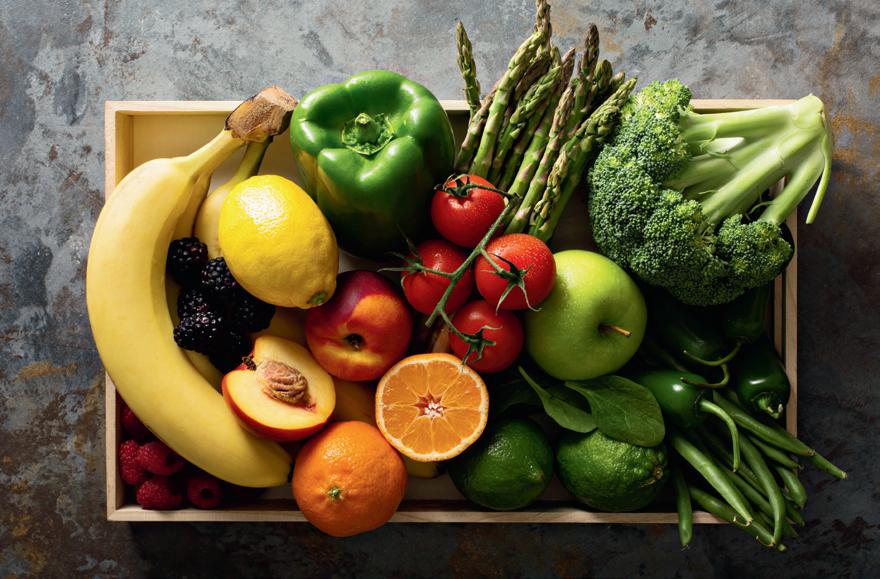
FreshFocus is an enterprise resource planning (ERP) solution, built on Microsoft technology, tailored to meet the challenges faced by the fresh food supply chain industry. The solution is designed to help businesses in the fresh food industry move, track and trace products to provide quick, efficient and transparent operations.
An output of research has discovered that by modifying osmotic dehydration methods, using alternative osmotic agents, conventional salts and sugars can be replaced leading to healthier foods. The development of edible coatings as a methodology to extend shelf life is also being studied.
Life cycle analysis and life cycle cost analysis are being studied throughout the value chain by various partners, including the University of Huddersfield. This will help determine the environmental impacts and identify the points that cause the most series environmental burdens, providing sustainable solutions at a reasonable cost.
The results of research from the first year were shared in three scientific publications and one conference presentation, with further outputs expected soon.
“The researchers taking part in the FRIETS project gain an in-depth understanding of industry requirements that transforms knowledge into next-generation products and services,” Angelis-Dimakis said.
Companies involved will also be able to reap benefits as the research is expected to enhance and add value to their products and processes, according to Angelis-Dimakis.
The technology aims to streamline operations and enhance traceability. Through seamless integration and data exchange capabilities, end-to-end tracking of produce and a farm accounting module for real-time resource allocation and cost management, the solution is designed to deliver efficiency and transparency.
Developed in collaboration with industry leaders and a dedicated internal team of IT specialists at NCS Australia, the solution is designed to address the problem of siloed systems within this sector, along with the complexity and lack of mobility hindering fresh food producers from having access to accurate, real-time data when needed.
The solution is designed to deliver real-time results, rectifying issues before they escalate and enabling smarter decisionmaking based on comprehensive data analysis.
FreshFocus will be available in early 2024, replacing or enhancing existing solutions currently supported by NCS Australia.
NCS Australia
ncsnz.co.nz
Humble vegetables ignited hot debate in June this year when ice cream featuring pumpkin and cauliflower was served to more than 3000 people at the nation’s annual Hort Connections event in Adelaide.
The two bespoke savoury-meets-sweet gelato flavour combinations included cauliflower–vanilla bean and pumpkin–ginger bread. With one serve of veggies in every two scoops, the gelatos are designed to be delicious and nutritious.
The flavours were developed through Research and Development Corporation Hort Innovation, in partnership with grower-owned vegetable waste company Nutri-V. The pumpkin and cauliflower that would be otherwise lost to the supply chain are transformed into a nutritious powder that can be added to a range of meals and drinks, and even ice cream.
Hort Innovation Chief Executive Officer Brett Fifield said that finding innovative ways to reduce food waste while also encouraging consumers to eat more fruits, vegetables and nuts is an increasing industry priority.

“Research shows that 96% of the population do not eat the recommended amount of vegetables each day — which is five to six serves,” Fifield said. “Ice cream is a popular dessert, why not get a health boost through it.”

“Less than 1% of hard vegetables, such as pumpkin and cauliflower, are consumed as desserts — maybe this is an untapped market.”
Raquel Said from the grower-led initiative explains that the Nutri V powders were born from a farming business with a passion for innovation and sustainability.
“Part of growing veggies can involve ending up with tonnes that do not meet retail specification or there is an oversupply or excess stalks and leaves, yet it is all still perfectly nutritious,” she said.
“We upcycle that waste into a sustainable yet delicious solution. This ice cream features vegetables reimagined. It is the future of helping Australians top up their veggie consumption while supporting farmers to reduce waste.”
The ice cream builds on previous work undertaken between Hort Innovation, Nutri V and CSIRO, Australia’s national science agency, that developed the innovative vegetable powders.
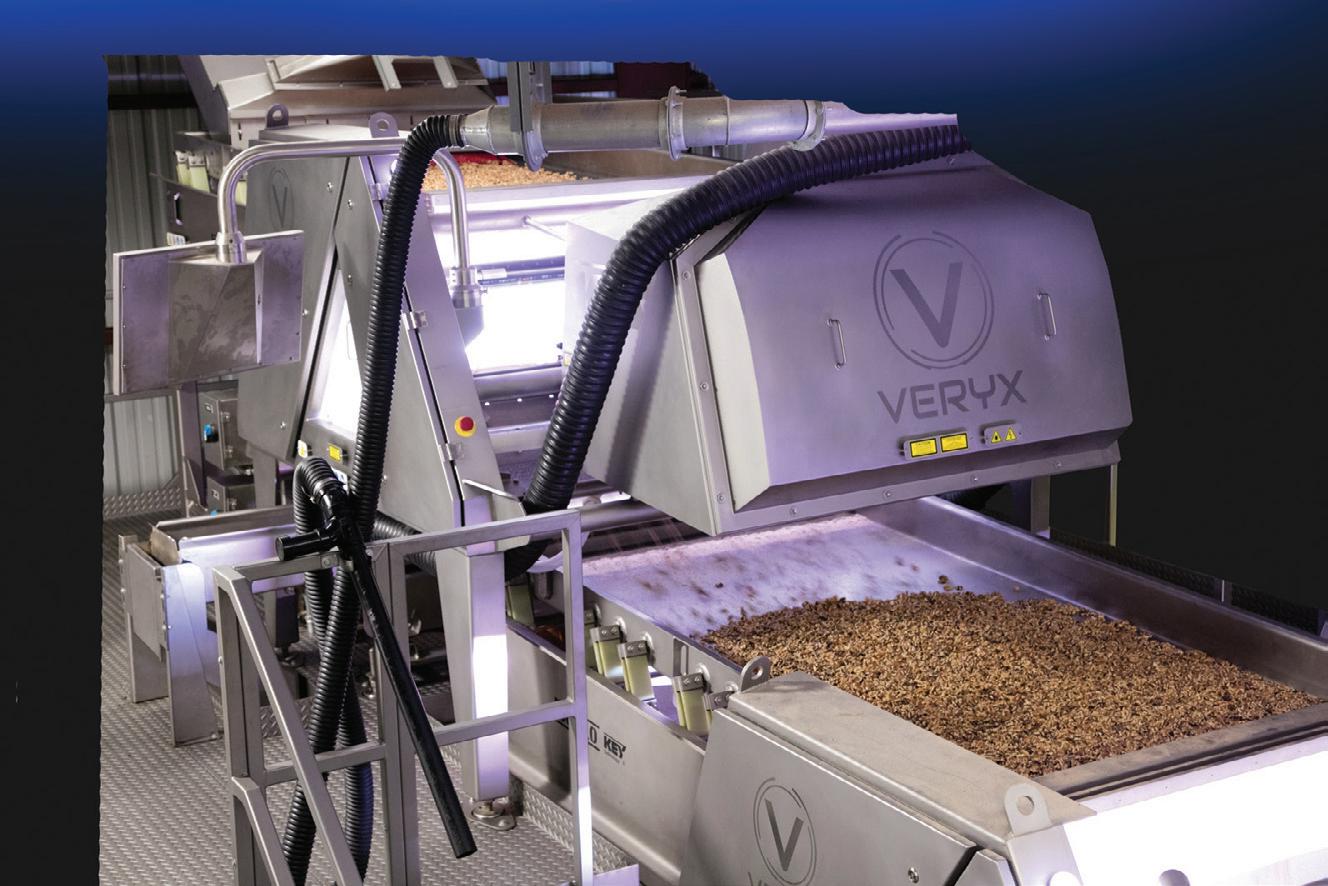


After an extended hiatus due to the pandemic, AIP will be back in person hosting an extensive range of educational programs alongside of FoodTech PackTech 2023. The AIP educational offerings include a full day of packaging sessions, a training course and a stand to visitors to meet the AIP education team.
The AIP Packaging Forum will be held 19 September within FoodTech PackTech 2023 at Auckland Showgrounds starting at 10.30 am and finishing around 4.30 pm.
The AIP, in partnership with the organisers of FoodTech PackTech, will be running a series of packaging sessions all day on 19 September. The sessions will be designed as panel discussions covering a broad range of topics including packaging targets, waste directives, sustainable and circular packaging innovations and designs, incorporating recycled content into packaging, the future of soft plastics and flexible packaging, how to embed the 10 Sustainable Packaging Design principles into your business, the role that packaging plays in minimising food waste, the future of fibre and renewable materials, the important role that the Australasian Recycling Labelling program plays across ANZ and updates for ANZPAC. The speakers will also include a number of NZ winners of the ANZ PIDA Awards and the WorldStar Packaging Awards.
Australian Institute of Packaging www.aipack.com.au
3159
Cuddon Freeze Dry has launched the GPC Cuddon Freeze Dryer range, which has been optimised for natural CO2 refrigerant without any loss of performance and designed to achieve a significant reduction in environmental impact.

Design improvements to the product chamber and robotic manufacturing processes have reduced manufacture times while increasing product capacity by nearly 30%.
Smart engineering has facilitated lower shelf temperatures of -35°C, while a fully incorporated heat recovery system harvests the ejected heat from the refrigeration system and uses it to heat the defrost water and product shelves.
Together with the anodised aluminium product trays and an upgraded smart control system, the result is a significant drop in the power consumption of this traditionally power-hungry drying process. The range is designed to freeze-dry more product in a shorter cycle time, with lower operational energy and refrigerant costs.
Cuddon Freeze Dry www.cuddonfreezedry.com
Advanced Packaging Systems (APS) is a supplier of processing and packaging equipment to manufacturing industries. Established for over 23 years, the company represents European and US original equipment manufacturers (OEM) within New Zealand.
The equipment distributed by APS includes the range of Silverson High Shear Mixers, which are suitable for mixing applications such as blending, disintegrating, emulsifying, homogenising, suspending, solubilising and particle size reduction. Russell Finex vibratory sieving and filtration equipment and wire mesh conveyor belting stainless steel conveyor belts and specialised conveyors are also distributed by the company.
APS is the exclusive agent across Asia Pacific for Dinnissen, which manufactures blenders for powders and granulated products.
Hanningfield, which manufactures conical milling machines for particle size reduction, is represented exclusively in New Zealand by APS.
The equipment can be viewed on stand 3159 at Foodtech Packtech 2023.
Advanced Packaging Systems Ltd www.advancedpackaging.co.nz
Everything from packaging, food processing equipment, ingredients, food safety and sustainability will be on show 19–21 September at Foodtech Packtech 2023.


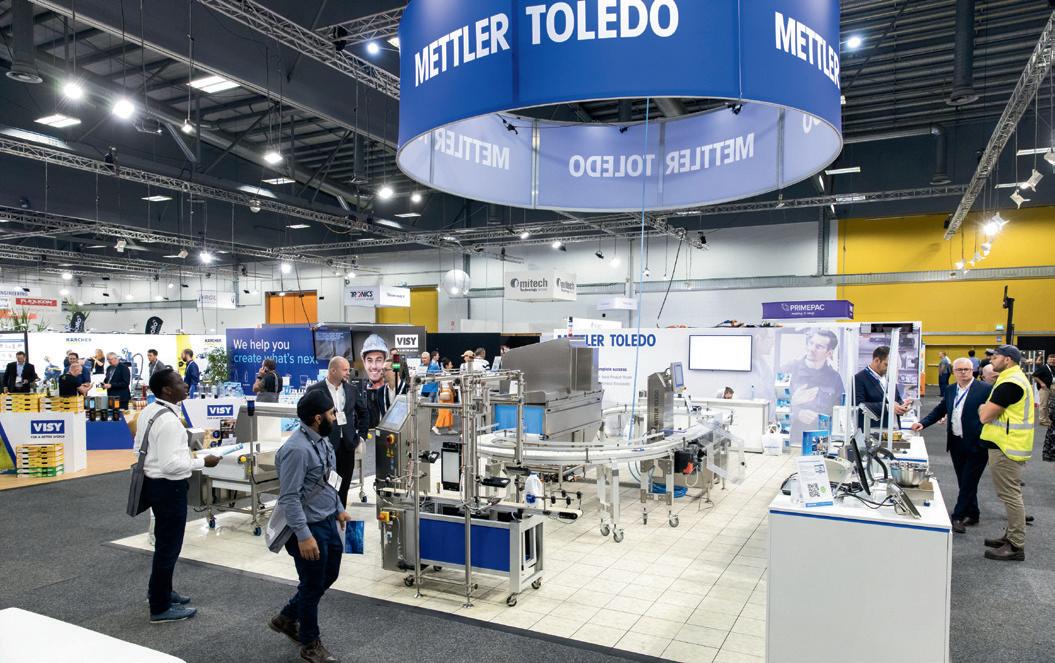
Held at the Auckland Showgrounds, the event will include over 225 exhibitors showcasing meat processing equipment, food-grade hydraulic presses, flexible packaging options, food processing equipment, precision instruments for weighing — and that’s just a start!
The event also features a new food ingredients area called The Pantry, which includes exhibitors such as ICMD, Formula Foods and Carmi Flavours.
Of course, the event is not just about showcasing new technology and products. It’s also an opportunity to learn and collaborate with industry peers. There will be seminars and workshops across the three days covering all the show’s
categories, providing an immersive platform for attendees to learn about the latest advancements in food technology and to collaborate on solutions that will shape the future of the industry.
The What’s New in Food Technology & Manufacturing team will also be onsite to talk with exhibitors and industry visitors face to face on stand 3162.
Organised by XPO Exhibitions, Foodtech Packtech featuring the Materials Handling & Logistics Expo runs from 19–21 September at the Auckland Showgrounds.

Eriez Xtreme Metal Detectors are highly sensitive to detect small ferrous and nonferrous metal contaminants such as needles, scale, rust, nails, clips, bolts, nuts, staples, stainless steel, aluminium and copper alloys in loose or free-fall food processing systems and final packaged food lines. The unit is designed to detect metal contaminants throughout the manufacturing process, from the moment ingredients enter the processing plant until the product is shipped.
The metal detector has an easy-to-use touchscreen interface, intuitive product set-up and reporting, multiple USB and interface ports, and remote access, all contained in the standard IP69 highpressure washdown design.
The equipment complies with food safety standards and is suitable for any industry, especially food, packaging, plastics, pharmaceuticals, rubber, chemical and more. Eriez has units of various heights and widths available for quick shipment from its global manufacturing centres. In addition to standard models, the company has custom designs to meet users’ unique application needs.
Eriez will exhibit at Foodtech Packtech in Auckland from 19–21 September 2023 at stand 3042.
Eriez Magnetics Pty Ltd www.eriez.com.au
3137


This case study explores how the adoption of the Ebro ViDOS Vibrating Dosing Valve addressed key challenges faced by a food processing plant by providing good sealing, dosing and product integrity.
Efficiency and precision are crucial in the industry, especially when it comes to dry powder handling. This case study focuses on a food processing facility with a dry powder vacuum loader above a process mixer that required a valve to isolate the two vessels.
The plant faced three primary challenges:
1. Achieving a reliable seal between the vessels for tight shut-off.
2. Ensuring accurate and precise dosing of the powder.
3. Minimising product degradation.
Traditional solutions such as rotary airlocks and screw feeders fell short of meeting these requirements. To overcome these challenges, the food processing plant adopted the EBRO ViDOS Vibrating Dosing Valve which provided it with advantages over conventional butterfly valves, rotary airlocks and screw feeders in terms of performance, accuracy and space efficiency.
The solution provides compact dimensions without compromising accuracy or repeatability. Its integration of a 4–20 mA positioner and a mounted vibrator allowed controlled flow at low feed rates and precise filling of containers.
Ebro Armaturen Pacific Pty Ltd www.ebro-armaturen.com.au

When Lion Beer Australia started thinking about what its supply chain of the future might look like, they knew they needed to improve productivity to keep up with demand, and adopt processes and technologies that would deliver optimum services for Lion’s people, brands, production facilities and suppliers.
The fleet of Dematic AGVs at Tooheys are helping achieve just that — giving Lion dependable seamless performance for its end-of-line process, keeping product moving accurately and safely to the end consumer.

See the video and read the full case study at Dematic.com
Dematic.com

02 9486 5555
info.anz@dematic.com

Dematic AGVs help keep the beer flowing at Tooheys Brewery.Tooheys
The BLOCK-BUSTERÒ Hydraulic Bulk Bag Conditioner from Flexicon features arched doorway masts that increase overhead clearance for easier insertion and removal of palletised bulk bags using a forklift.

The conditioner loosens hygroscopic chemicals, spice blends, heat-sensitive products and other bulk materials that have solidified during storage and shipment, returning the material to a free-flowing state and enabling bulk bag unloaders to discharge the material through bag spouts.
A hydraulically actuated, variable-height turntable operates in concert with two hydraulic rams to press opposing sides of the bulk bag at varying heights, rotate the bag 90 degrees and then repeat the conditioning cycle.
The number and pressure of hydraulic ram actuations, the height of the turntable and the number of 90-degree rotations are user programmable at the control panel’s HMI.
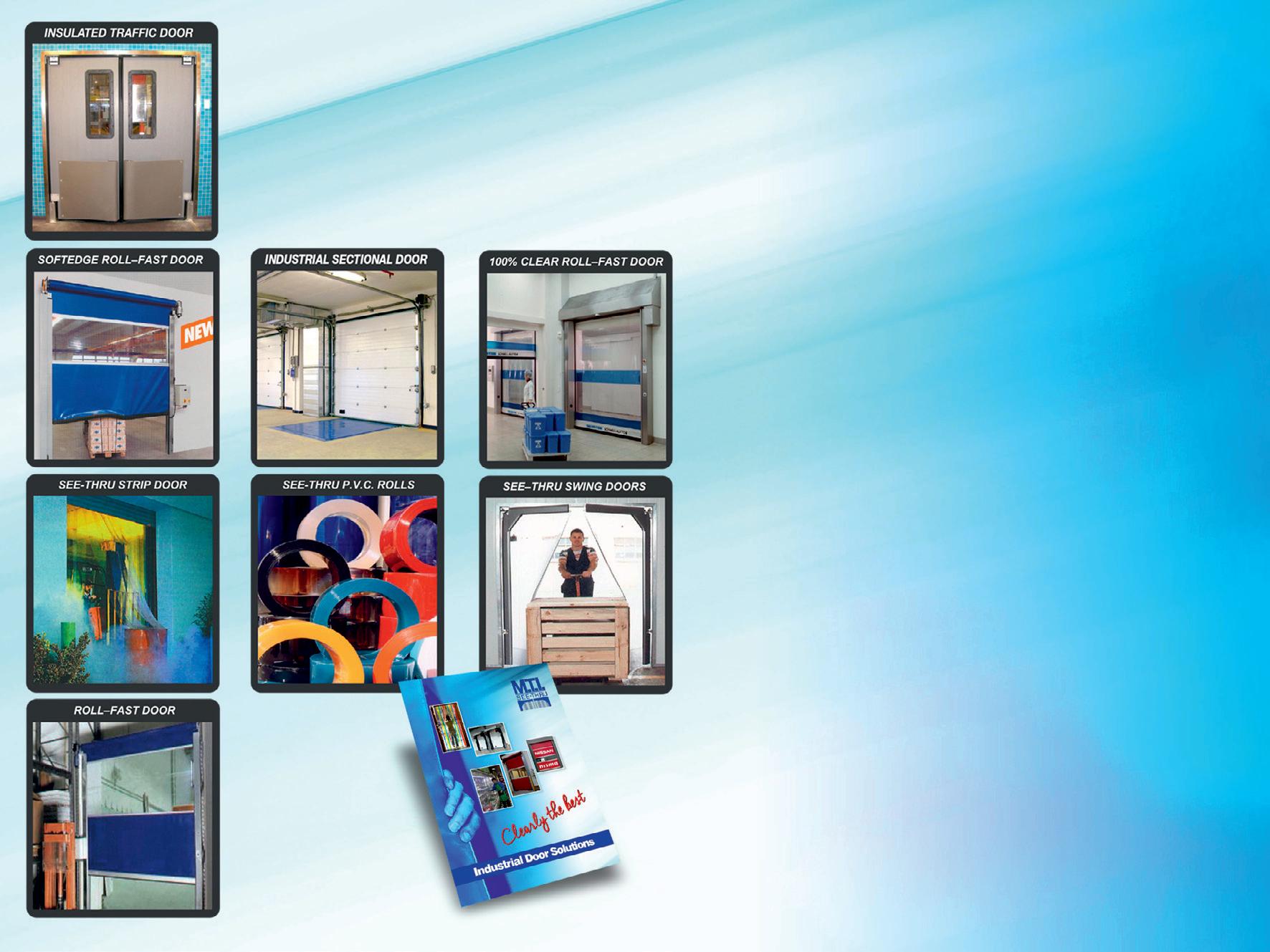
Enclosed on four sides, the conditioner is equipped with full-height, safety-interlocked doors that disable all equipment functions when the doors are open.
The system's hydraulic pump can be mounted on the exterior of the safety cage or remotely, and requires only an electrical power connection for operation.
Available through the company’s Quick-Ship Programme as a standalone unit, the conditioner accommodates bulk bags of all popular sizes. It is also available constructed of stainless steel for sanitary and corrosive applications, and in configurations integral to bulk bag dischargers that reduce the cost, footprint and loading time of separate equipment.
Flexicon Corporation (Aust) Pty Ltd
www.flexicon.com.au
Interworld Electronics has introduced the new generation ViTAM-821B 21 ″ IP66/IP69K Stainless Steel Panel PC from APLEX Technology.
Just like other models in the ViTAM series, the ViTAM821B is a stainless-steel panel PC solution with a wide range of features suitable for food and beverage manufacturing. This new generation panel PC is powered by an Intel Celeron J6412 processor with integrated graphics processing. With this processor and support for Windows 10 and 11, this model offers a balance between performance, quality and cost compared to other models in the series.
The ViTAM-821B is fully enclosed with SUS304 (optional SUS316) stainless steel which provides anticorrosion, anti-bacteria and anti-oxidation protection, making it durable and rugged, even when exposed to harsh conditions. It also comes with IP66/69K water and dust protection, a fanless design and M12 connectors for I/O ports, which helps to prevent any water, dirt or grime entering the system. It is also able to operate under a wide temperature range (0~50°C) and is able to resist high-pressure (100 bar) cleaning. These industrial-grade features make it easy to clean, can help reduce maintenance costs and provide a long-lasting, rugged enclosure.
The 21 ″ full HD (1920 x 1080) TFT-LCD is integrated into the chassis with a true flat front bezel design. The ViTAM-821B supports resistive touch or projected capacitive touch and has a high brightness display option. It also has many other options/features that can be customised to suit a range of applications.

Interworld Electronics and Computer Industries www.ieci.com.au

Generative AI (GAI) has been revolutionising the way we create, design and innovate. Now a new report has found that Australia’s manufacturing sector could unlock billions of dollars in value by 2030 if it accelerates the responsible adoption of generative artificial intelligence (GAI).

The report, Australia’s Generative AI Opportunity, is a joint collaboration between Microsoft and the Tech Council of Australia. It shows that GAI could contribute between $45 billion and $115 billion a year to Australia’s economy by 2030 through two major channels: improving existing industries and enabling the creation of new products and services.
Manufacturing has been identified as one of the four key sectors of the Australian economy poised to benefit from GAI. The report found that the technology could contribute between $2 billion and $5 billion annually to the manufacturing sector by 2030.
Kate Pounder, CEO of Tech Council of Australia, said the report shows the economic potential of GAI in the sector, but warned that the sector risks falling behind other industries in the adoption of this technology if it fails to accelerate its digital transformation.
In areas such as predictive maintenance, quality control and robotics, AI is already applied by manufacturers. GAI can further uplift the sector by using data patterns to generate new content such as images, text or designs. This can impact manufacturing areas where AI hasn’t been used, including designing or recommending products based on trending features, upskilling apprentices and technicians and automating supply network controls.
For managers in the sector, the report estimates that GAI could automate 30% and augment 19% of tasks, leaving more time for complex and strategic activities. It can also enhance
on-the-job learning for technicians and trade workers through rapid upskilling and training.
However, the report cites several challenges facing the sector in its adoption of GAI. While 72% of manufacturers increased their digital transformation efforts throughout the COVID pandemic, only 20% currently use AI. If not addressed, this could cause the manufacturing sector to lag behind other sectors in this area.
Lee Hickin, Chief Technology Officer at Microsoft Australia and New Zealand, said: “We’re proud to partner with the Tech Council on this timely report. Generative AI has emerged as a transformative technology in 2023, with its adoption growing rapidly across various sectors in Australia. There’s a huge opportunity for the manufacturing sector as it deploys generative AI to support workforce transformation, enhance smart factories and supply chain resilience, and accelerate innovation.”
The report notes that deeper collaboration is needed between industry and government for Australia to capture the economic benefits of this technology and become a global leader in GAI.
A key to spurring the collaboration will be to leverage Australia’s comparative advantages in digital technology, including a large and highly skilled workforce, strong investment and a high level of cloud computing adoption.
The report also identified barriers that industry and government face in capitalising on GAI in four key areas: technology capability, enterprise readiness, awareness and skills and responsible AI.
It also outlines strategic actions that adopters and policymakers need to take for Australia to overcome these challenges. These include defining the opportunity and vision for GAI, assessing readiness, incentivising adoption and innovation, upskilling the workforce and developing responsible AI governance frameworks.




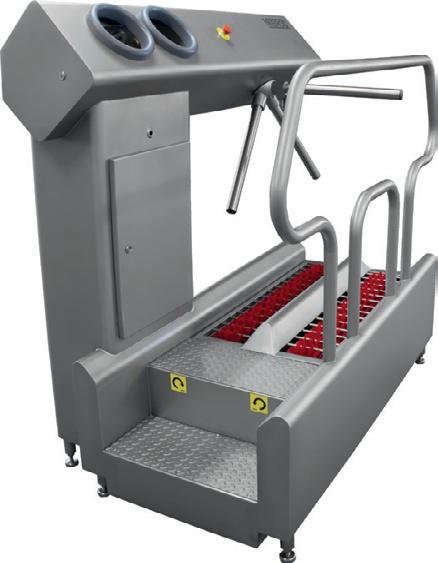





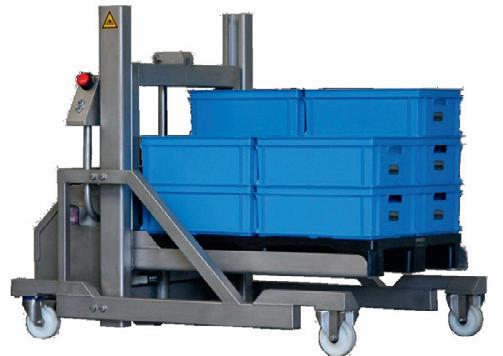


Tompkins Robotics is expanding its robotic solution offerings with the PickPal product series, which is a line of pick assist (PA) autonomous mobile robots (AMRs). There are currently two models in the series: the standard PickPal, which can carry 60 kg of orders, and the PickPal+, which handles up to 100 kg of orders. There are additional PickPal+ models planned to carry more orders, with higher capacity, and that apply pick assist technology to case picking.

Moving at 1.4 m/s, the robots carry orders between workers, and can group orders together to minimise travel and increase productivity. Each model can be fitted with a variety of shelf and tote configurations.
The company says PickPal provides a quickly implemented and low operating-cost robotic technology that can be inserted into existing operations doing order fulfilment in a scalable robotics-as-aservice (RaaS) model.



Primary Sight
http://primarysight.com.au



GEA has launched a new generation of twin screw pumps for food, beverage and pharmaceutical applications that combine conveying and cleaning functions in one pump. More powerful than its predecessor, the GEA Hilge NOVATWIN+ has a higher flow rate and covers a wider range of applications with a smaller pump, allowing users to reduce their material footprint by 23% and save 10% energy.


With variable speeds of up to 3000 rpm, the self-priming positive displacement pump conveys lumpy, shear-sensitive and abrasive media gently. It can handle liquids with a range of viscosities. As the pump operates almost without pulsation, it is suitable for large and sensitive particles, eg, in the processing of cheese curds, quark, yoghurt and highprotein beverages, as well as plant-based products.

Suitable for the dairy industry, twin screw pumps can serve as CIP pumps because they can be operated at high speeds, and the system pressure of 30 bar also allows for use in high-pressure applications.
Pump maintenance is simplified by the integrated blocking tool for tightening and untightening screws in the gearbox. The patented adjustment directly on the screws does not require oil drainage or complete disassembly of the pump.



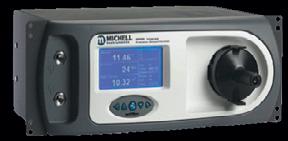


GEA Group

www.gea.com

The Australian Renewable Energy Agency (ARENA) has announced $3.7 million in funding to Enel X to demonstrate and scale flexible demand solutions in the commercial and industrial refrigeration sector. The ‘Unlocking Flexible Demand in the Commercial Refrigeration Sector’ project seeks to recruit 440 supermarkets and 13 refrigerated warehouses to aggregate 20.9 MW of flexible demand across the National Electricity Market.
The supermarkets and warehouses will participate within Enel X’s virtual power plant (VPP) to provide services supporting Australia’s electricity system. The facilities involved will help alleviate grid constraints and support the supply of electricity to consumers while being financially rewarded for doing so via Enel X’s VPP.

With an estimated 500 MW of potential flexible demand in refrigeration across Australia’s supermarkets, grocery stores, beverage shops and warehouses, commercial and industrial refrigeration provide a source of flexible demand on a large scale. Flexible demand is the coordinated orchestration of electrical load to ease pressure on the grid. With renewable sources such as wind and solar producing a greater share of Australia’s electricity generation, solutions are required to match up supply and demand.
Energy storage is part of the equation, but it can be complemented by shifting demand away from peak times and reducing demand at critical times, helping reduce the overall cost of energy and support integration of renewables into the grid.
Refrigeration offers a valuable source of flexible demand due to the thermal mass of facilities maintaining temperatures when refrigerators and chillers are ramped down. Small
changes to power usage can have a large impact when aggregated to scale without any noticeable change for users or impact on product quality.
Enel X has recruited a Tier 1 Grocery chain as its initial supermarket partner, piloting 20 stores with the aim of extending up to 250 stores participating in the VPP. Lineage Logistics will also be involved in the project with 13 refrigerated warehouse sites. Enel X is actively recruiting commercial refrigeration businesses across supermarket, grocery, beverage, convenience and last mile logistics to fulfil ARENA’s 440 store funding support.
The project aims to demonstrate the business case for flexible demand solutions in refrigeration and to lessen the risk of uptake of new technology for prospective demand response providers.
The project is designed to pave the way for further investment in flexible demand, according to ARENA CEO Darren Miller.
“Our electricity grid is changing, and a more variable supply requires more flexible demand,” Miller said.
“Commercial refrigeration can unlock this opportunity at a material scale, so we’re excited to see the Enel X project rolled out across Australian supermarkets and other businesses with refrigeration.”
Jeff Renaud, Enel X APAC Managing Director, said ARENA’s support will help in demonstrating that small-scale refrigeration systems can make large-scale contributions to the renewable energy transition when plugged into a virtual power plant.
The ‘Unlocking Flexible Demand in the Commercial Refrigeration Sector’ project is due to be completed in 2027.
Tiny bubbles and the carbonation kick are all part of the champagne and sparkling wine experience, but how long can these drinks be stored before they go flat? The answer is that it depends on the bottle size, according to researchers reporting in the ACS Omega.
The researchers found that vintages in magnums retained their bubbles more efficiently during prolonged aging than the same vintages in standard bottles — they estimated a 40-year shelf life for 950 mL bottles, 82 years for 1.5 L bottles and 132 years for 3 L bottles.
When it comes to champagne and sparkling wines, dissolved CO2 is a key compound responsible for the much sought-after effervescence in glasses. Carbon dioxide is produced by combining yeasts, sugar and wine — which also produces additional alcohol. Although the yeast dies within a few months, complex aromas develop as the bottles age undisturbed for 15 months to several decades. While this happens, the beverage is losing carbon dioxide, which slowly escapes through the sealed

metal caps or corks. Gérard Liger-Belair from the University of Reims Champagne-Ardenne and colleagues wanted to know how the size of the bottle influenced how long champagne can be aged before it goes flat.
The researchers measured the carbon dioxide in different champagne vintages aged for multiple decades and estimated the original amount of yeast-produced carbon dioxide. They found that the amount of gas inside the vessels, which were sealed with metal caps, decreased the longer the bottles aged. The oldest vintage from 1974 lost the most carbonation, nearly 80%. The team also found a correlation between the volume of a bottle and the carbon dioxide level, with larger bottles retaining gas better than smaller ones.
The researchers developed a formula to calculate a bottle’s shelf life, or how long aged champagne would spontaneously produce bubbles when poured in a glass. They predicted a shelf life of 40 years for standard 750 mL bottles, 82 years for 1.5 L bottles and 132 years for 3 L bottles, after which point the champagne would be flat. From their large selection of aged champagne, going back nearly 50 years, the researchers say they’ve shown how the drink’s bubbliness over time depends on the bottle’s size.
The findings have been published in the American Chemical Society’s journal ACS Omega.
Endress+Hauser has launched FieldGate SWG50, a WirelessHART gateway primed for secure communication from field devices. FieldGate SWG50 is compact and ready for Netilion integration while providing an easy-to-use solution for multiple standard monitoring applications across various industries. Netilion is a cloud-based IIoT ecosystem designed for industrial processes, connecting the physical and digital worlds to send information from the field straight to a phone, tablet or another device.
The WirelessHART gateway FieldGate SWG50 enables users to monitor measurements and health statuses using WirelessHART connectivity. This offering is an alternative to cable installations, reducing expenditure for process automation by up to 30%. It adapts to the process plant, both in greenfield and brownfield applications, giving access to digital communication.
FieldGate SWG50 can be paired with Endress+Hauser’s FieldPort SWA70 and SWA50 adapters. It also integrates with any WirelessHART device on the market. FieldGate SWG50 allows for network migration, has a colour coded device list, 4 x RJ-45 connectors, redundant power supply, Modbus TCP and HART-IP outputs, indoor housing rated at IP20 with DIN rail mounting, connection to 100 nodes and CommDTM to see and configure devices behind SWA50 and SWA70 in FieldCare.

Endress+Hauser Australia Pty Ltd
www.au.endress.com

Balluff has released the BVS ID sensor, designed to read barcodes, 2D codes and DMC codes.
With Balluf’s SensorApp software, the sensor offers autosetup features with configuration and monitoring options via a web browser. The sensor also offers integration with automation and IT systems due to standardised interfaces.
The product also provides additional condition monitoring information when integrated into an IO-Link network, providing access to vibration, temperature, code quality and operating time. MQTT and REST API protocols enable IIoT communication, facilitating data exchange for Industry 4.0 initiatives.
The sensor comes in three versions. The BVS0060 has red and white LED illumination, and the BVS0061 has white and infrared illumination, both with IO-Link and Gigabit Ethernet interfaces. The BVS01A0 offers red LED illumination and a USB interface only.
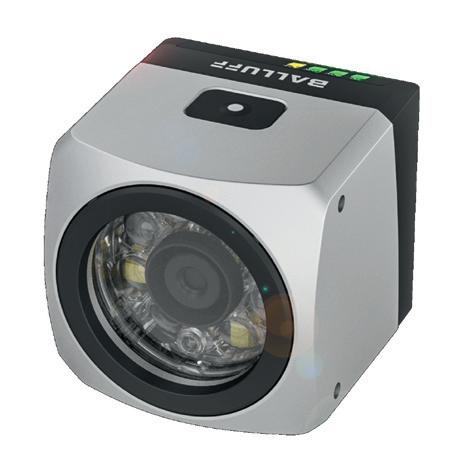
Balluff Pty Ltd
www.balluff.com.au
The CSD/CSDX range of rotary screw compressors from Kaeser Compressors are designed to perform with low energy consumption. The ‘.6’ iteration of the CSD/CSDX series includes drives with the best possible efficiency class, whether speed-controlled (IE5) or fixed-speed (IE4). The centrepiece of all compressors in the series is the rotary screw airend with flow-optimised Sigma Profile rotors, specially developed for this performance range. Other improvements, such as speed-controlled fan motors, have enabled the energy efficiency of the compressor system to be enhanced. The new design has also led to improved accessibility to all relevant components and therefore increased maintenance-friendliness.


Featuring motors with power from 45 to 90 kW, models from this series can cover delivery volumes from 8.4 to 19.4 m3/min and are designed for pressures up to 15 bar. Particularly at low pressures, even higher delivery volumes can be achieved.
The environmentally friendly system design even extends to the fluid filter elements: they are metal-free and after use can simply be thermally disposed of without need of further treatment.
In addition to the standard versions, versions with an add-on refrigeration dryer module are available, which permit both compressed air generation and drying in a comparatively small space. The refrigeration dryer is dimensioned for high ambient temperatures and operates with very little pressure loss. In comparison to the previous version, energy consumption has been reduced significantly, while the required refrigerant charge is also around 25% lower. The dryer is accommodated in a separate housing and is therefore not negatively influenced thermally by the exhaust air from the compressor.
The CSD.6 and CSDX.6 are both available with variable speed control.

Kaeser Compressors Australia
au.kaeser.com
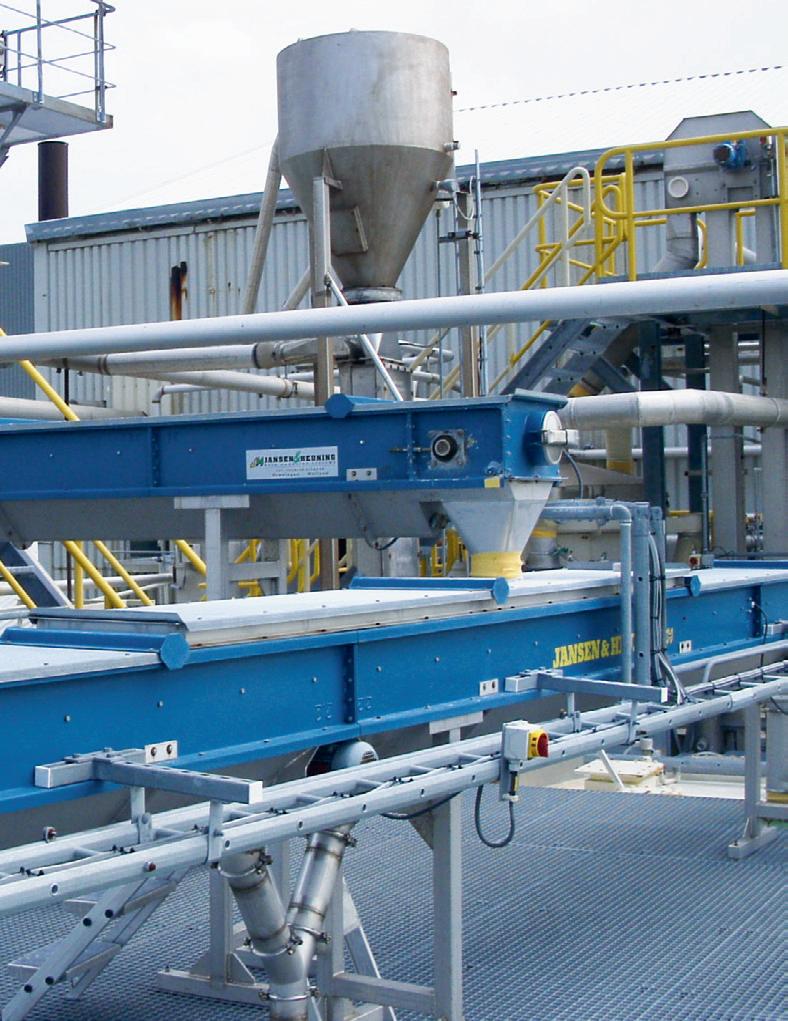
Sean Trebley, Environmental Manager for Northern Victoria, was given the task of upgrading the wastewater aeration system at Bega’s Strathmerton plant. The existing system consisted of a dissolved air floatation (DAF) unit, which flowed into an aerated lagoon. The resulting effluent was stored in two non-aerated lagoons during winter, with irrigation occurring in summer.
Over several years, the aging surface aerators had progressively failed, with repairs requiring the deployment of cranes and boats to gain access. This process was expensive and resulted in damage to the dam liner. Eventually, it became uneconomical to keep repairing the aerators.

Hydro Innovations recommended the installation of a bankmounted Gorman-Rupp EchoStorm aerator for the lagoon to replace the surface aerators and an EDUR DAF pump to replace the existing pump/compressor/pressure tank system.

The 1 kW EDUR PBU 201 DAF pump eliminates the need for the 7 kW recycled pump and the three-phase air compressor, helping save energy costs. The pump has allowed the water to be aerated more efficiently and effectively before being transferred to the lagoon.
Operators have observed a continued increase in the dissolved oxygen level in the lagoon and have seen COD fall by 50% since installation. Due to the higher level of mixing, re-suspending settled solids became more bioavailable to colony-forming units.
Operators in Germany and the USA have been benefiting from similar upgrades for decades, retrofitting EDUR DAF pumps to older DAF systems to improve their efficiency and reduce maintenance costs. Systems from 1 to 22 kW are available with a range of materials including cast iron, stainless steel and super duplex.
Hydro Innovations

www.hydroinnovations.com.au

The Monnit Commercial Refrigeration Temperature Monitoring Kit is an all-in-one solution for commercial refrigeration and cold store monitoring. With the kit, temperature-sensitive inventory is constantly being tracked and monitored.


Equipped with the advanced Monnit Temperature Wireless Sensors, the kit allows users to closely monitor the temperature of their chilled or frozen products. Should there be any unexpected fluctuations, users will be instantly alerted so immediate action can be taken to protect inventory.
The convenience of the kit extends beyond real-time monitoring. With the ability to remotely check the performance of a commercial refrigeration and cold storage system from anywhere at any time, users can stay connected and in control, even when not onsite. Designed to provide convenience and peace of mind, the kit can also help with compliance to health and food safety regulations. The temperature sensors constantly log readings and securely store all data, making it easy for users to access and provide accurate records when needed.
Easy to install, maintain and review, the kit is designed to provide cost-effective efficient temperature monitoring to eliminate unnecessary risks with cold storage

OneTemp Pty Ltd
www.onetemp.com.au

2123
SICK has expanded its Ruler3000 range of 3D streaming cameras with the launch of three compact cameras, as well as an additional mid-range variant. The Ruler3000 cameras now span fields of view between 26.6 and 1680 mm, down to heights of 0.8 µm.
The SICK Ruler3000 range combines the image quality of the company’s Ranger3 streaming camera with the addition of a builtin laser, pre-selected optics and factory-calibrated fields of view.
The SICK Ruler3002, 3004 and 3010 cameras with a highpowered blue 3R laser give the three smaller cameras the rapid exposure times necessary to capture very small three-dimensional details at high production speeds. These cameras are designed to extend the capabilities of the Ruler3000 to the smallest details required to inspect electronics and consumer goods assemblies, printed circuit boards and semiconductors. The addition of the mid-range Ruler 3060, with a field of view of 740 mm is targeted at applications in the automotive and consumer goods industries.
By capturing 3D images, reflectance and scattered light measurements in a single scan at speeds of up to 46 kHz, the Ruler3000 cameras can distinguish differing material properties, useful for example in the cutting of timber and the portioning of meat. The cameras’ high light sensitivity and high dynamic range also help optimise inspections independent of contrast, or widely differing light remissions, in a single scene.
SICK Pty Ltd
www.sick.com.au

“To fit perfectly in SAB’s hall concept this line is extremely compact, with shared operating areas. This allows operators to attend to multiple machines, thereby reducing the number of operators required,” said Boris Tremmel, Head of Key Account Sales at Krones.

The Ergomodul modular labeller features interchangeable labelling stations, making it possible to switch over to the beer currently in production. Since Corona bottles feature applied ceramic labels, they simply bypass the labeller.
The line also runs two different packers, giving SAB more choices — the Variopac Pro WT for wraparound cartons and trays and the Variopac Pro PFS for shrink packs. The Variopac Pro offers easy changeovers and expansion, so changes to packaging concepts can be accommodated at any time.
Beck’s, Corona and Budweiser, globally known brands of beer, come from Anheuser Busch InBev, a brewing group that produces around one-third of the world’s beer. The group’s portfolio comprises 630 brands, made in 260 breweries. It employs more than 170,000 people in over 150 countries.
In South Africa, it operates seven breweries, including the Pretoria South African Breweries (SAB) site with almost 900 employees. This plant produces South African brand Castle Lite and Corona, adding up to 8.5 million hectolitres each year. To boost production of Corona, the company has added a non-returnable glass line from Krones.
The glass line features two separate lines running in parallel, each with the capacity to fill 50,000 bottles per hour. This offers AB InBev a high output and the flexibility to handle different beers in parallel.
Another feature is the use of the multifunctional clamping starwheel MultiGuide Base. Since the top and bottom clamps can be opened independently of each other, it can securely grip bottles with varying diameters, minimising the need for manual intervention during format changeovers.

Krones Pacific Pty Ltd www.krones.com


Siemens’ partner APS to manufacture and adapt critical technology for Australia’s energy transition in Adelaide


Siemens and its national distribution partner APS Industrial (APS) have announced the opening of a new manufacturing facility in Adelaide. The new facility will manufacture and assemble a range of critical technology, including Siemens’ air circuit breakers (ACBs), and inject over 150 technology jobs into the local industry over the next 10 years.
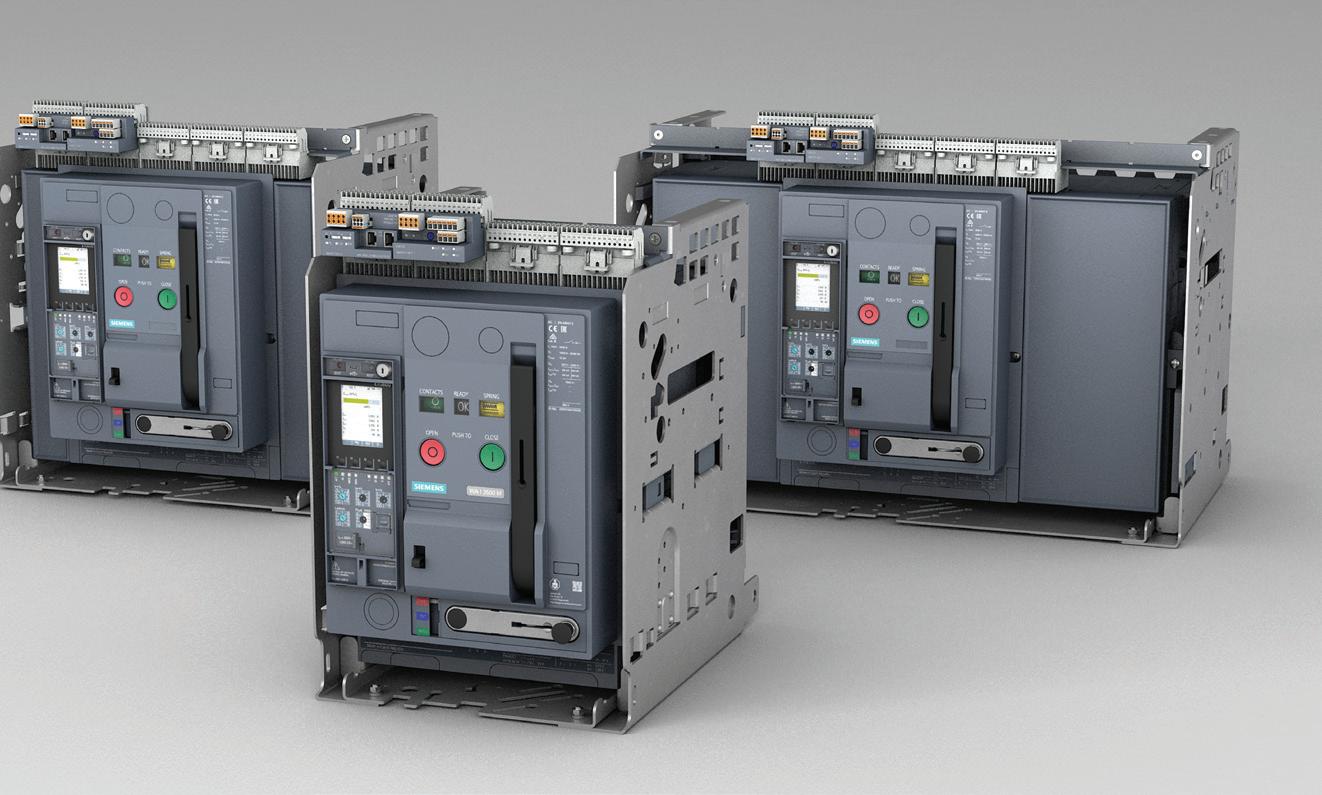
Local Australian manufacturing will also help reduce current ACBs product availability lead times by as much as 50% and increase the footprint of locally manufactured systems.
Speaking at the announcement, Siemens Australia and New Zealand CEO Peter Halliday said, “This is the first time in the world that these Siemens products will be assembled and certified outside of a Siemens factory, giving the same quality assurances. This demonstrates the trust and ability of our
national distribution partner APS Industrial. APS will adapt and assemble Siemens ACBs and peripheral equipment right here in Adelaide, which is good for jobs, good for industry and good for the economy.”
The ACBs are a critical component of energy transition across industries, helping provide safe power supply, protecting valuable equipment at manufacturing sites, built environments, mine sites and any other infrastructure requiring a safe and secure source of electricity.
Joining senior management from Siemens and APS at the new facility, South Australian Deputy Premier Dr Susan Close welcomed the local investment saying, “Siemens and South Australia share a long history that goes back over 150 years. As South Australia continues to grow, we need like-minded
partners like Siemens and APS that help build our sovereign capability and protect critical infrastructure and industry. This investment and commitment to future jobs further cements the technological prowess and capabilities of our state.”
The facility will enable APS to accelerate the delivery of ACBs to switchboard builders and electrical contractors who install and serve the Australian and New Zealand markets.

Speaking at the launch event in Adelaide, APS CEO David Hegarty said, “This is a significant investment for all of us — APS, Siemens and for local industry. Five years ago, APS was formed as Siemens’ master distributor in Australia and since then, we have grown significantly in size and scale as we’ve helped electrify and digitalise industries.
“One of the biggest challenges to the growth of our industries over the last few years has been global supply chain issues. The establishment of this new facility will reduce the reliance of global supply chains for a product that is critical to many applications and industries. We’re proud to support local industry and jobs and keep giving them access to best-in-class global technology,” added Mr. Hegarty.
The new facility is conveniently located in Clarence Gardens, just a short distance from Adelaide’s CBD.
“Since we started our Australian operations in Adelaide in 1872 with the establishment of the Overland Telegraph, we’ve achieved several technology firsts with South Australia. I’m proud of our relationship with APS Industrial, and how this decision demonstrates an expansion of the Siemens footprint in South Australia and our longterm commitment to the state. With APS we are helping progress Australian industry and economy. We can’t expect industries to innovate and continue growth trajectories without access to the right resources. This is a significant move that helps address one of the most critical challenges being faced by industry today,” added Halliday.

Australia’s red meat and livestock turnover accounted for $67.7 billion in the 2020/1 financial year. Currently, more than 800 tonnes of beef are exported each year as the demand for quality meat continues to surge.
According to Australia’s Agriculture and Horticulture Development Board, Australia’s cattle herd is forecast to grow to 28.8 million heads this year (up by 4.5%).
Looking to New Zealand, around three-quarters of pastoral land and just under a third of New Zealand’s total land area is used for sheep and beef farming.
According to the New Zealand Herald, the country exported red meat products worth $885 million for the month of February alone. The meat industry continues to generate high export revenue and remains the country’s foremost manufacturing sector, providing 25,000-plus jobs.
And while local manufacturers work hard to keep up with the pace of exports, the Department of Agriculture has cited a short-term stumbling block which will see lower prices outweighing increases in export volumes. However, the momentum continues for many invested, long-standing farmers operating in the meat processing sector.
A prime example of an Australian agribusiness thriving in the red meat sector is Fletcher International Exports. “In 2021, SMC Corporation ANZ released a case study in proud partnership with Fletcher,” said Derek Haakman, Area Sales Manager for SMC New Zealand. “The company has two facilities in Australia that process a total of 90,000 sheep per week.”
He added that the magnitude of this sector should not be underestimated or overlooked. “The red meat supply chain encompasses the likes of animal harvesting, livestock sales, meat processing, packaging, wholesaling, transportation and more.
“Companies in the red meat sector are up against a host of challenges daily. These include high running costs, rigorous health and safety standards, quality product, enhanced productivity, fierce competition, geo-political factors, the climate and supply chain fluctuations, to name but a few.”
“Hygiene and the protection of the cold chain are two crucial considerations on the factory floor. Processing of livestock — from slaughtering to cutting/boning, freezing and finally packaging — must be carefully undertaken. Any oversights could be extremely costly and dangerous,” Haakman said.
When selecting automation components, manufacturers need to consider:
• cleaning and sanitation
• energy savings
• safety
• temperature control
• speed
• data collection and IoT technologies
• environmental and chemical resistance
• maintenance and support.
“At SMC we recognise the role that red meat manufacturers play and have developed products that meet HACCP, PRP and other hygienic requirements by the industry at large. Because downtime in this industry relates directly to product losses, and safety is critical, the products are robust and safe to meet the market requirements.”
Haakman said the SMC JSY5000-H clean design manifold valve series is suitable to the red meat sector. “The series is built to withstand the harsh meat processing environment and comes complete with an IP69K rating, as well as an outstanding flow rate and IO-Link compatibility.”
The JSX series of direct-operated 2-port solenoid valves are built to withstand the harsh demands of the processing floor too. “These valves offer an IP67 rating and a stainless steel construction. They’re also energy saving, consuming just 4 W when in use,” Haakman said.

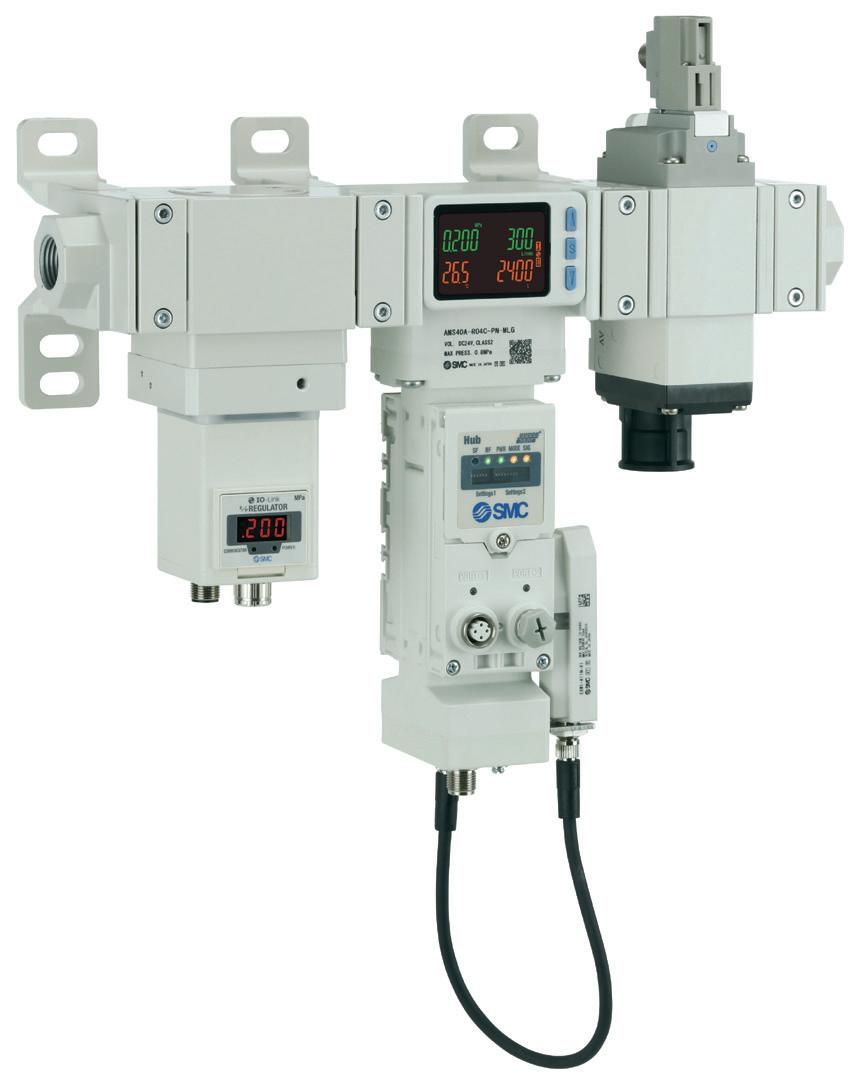
“Our hero product — the HY series of hygienic design cylinders — is water resistant and especially configured for easy cleaning.”
SMC’s stainless steel compact guide cylinder (MGP series) provides a reduced risk of line contamination due to labels falling off products. “This nifty cylinder eliminates the risk of a label peeling off a product when wet.”
SMC also introduced its new generation Air Management System (AMS) in March of this year. “Ideally positioned for the meat processing sector, this series is designed to reduce CO2 emissions and cut energy consumption by up to 62%.”
Dryers are a must-have on the factory floor, as Haakman explained: “A high-quality compressed air dryer is a non-negotiable. Our IDFA series is designed to perform in demanding environments and delivers dry compressed air, ideally suited for meat processing plants.”
Other must-haves include SMC’s TH series of fluoropolymer tubing and its range of EHEDG compliant fittings, suitable for washing at high temperatures.
SMC products are inherently manufactured with energy saving optimisation in mind. This has been part and parcel of product development at SMC for over a decade. “An Energy Saving Conservation Group also assist customers with measuring and managing air consumption to realise energy saving targets.”
To conclude, Haakman said that SMC is able to support meat processors with all their automation requirements. “We understand the importance of this sector and cater to all its requirements by supplying locally stocked products and a highly technical service team to answer their call for highquality, robust solutions.”
SMC Australia | New Zealand
www.smcanz.com
Meat scientists have used machine learning to help identify the cause of an old phenomenon in meat tenderness and determine how the ‘meat tenderisation enzyme’ calpain-1 can be modified.
When you bite into a steak, you’d prefer it to be juicy and tender, not tough — however, there’s a lot of science behind the spectrum from tough to tender.

Chaoyu Zhai, assistant professor of animal science in University of Connecticut’s College of Agriculture, Health and Natural Resources, recently published a paper in the Journal of Agricultural and Food Chemistry using machine learning algorithms to explain how the activity of an enzyme responsible for meat tenderness is modified on the molecular level.
An enzyme called calpain, specifically calpain-1, is known as the ‘meat tenderisation enzyme’. Calpain-1 cuts other proteins in the meat and makes these protein fragments more water-soluble. Having more fragmented protein molecules in meat makes it more tender.
While scientists have known about calpain-1’s role in meat tenderness since the 1990s, they didn't know much about how it can be modified.
“Protein modification is like a person wearing different clothes every day,” Zhai said. “It’s still the same ‘person’ but depending on the outfit, it may be better prepared to tackle different jobs.”
Scientists noticed that when meat is packaged with a higher concentration of oxygen, which helps preserve colour, the meat was tougher, but they didn’t know why.
Zhai and his collaborators discovered that the presence of compounds known as lipid peroxidation products can modify calpain-1 activity, explaining this mystery.
“We provided a new explanation for something we see a lot,” Zhai said. “By studying this, we help other researchers understand similar events.”
Lipid peroxidation occurs when lipids — such as cell membranes and fatty acids — are exposed to oxygen. Free radicals ‘steal’ electrons from lipids in cell membranes, causing cell damage. For example, lipid peroxidation occurs as perishable food gets older, causing it to degrade and smell.
In this paper, Zhai focused on three lipid peroxidation products: malondialdehyde (MDA), hexenal and 4-hydroxynon -
enal (HNE), which have been previously identified in meat.
These compounds have three, six and nine carbons, respectively. The more carbon molecules a compound has, the more hydrophobic, or water repelling, it tends to be. This means that these compounds likely inhibit calpain activity at different levels.
“When the carbon chain number increases, those compounds tend to be more hydrophobic,” Zhai said. “They will potentially cause more functional changes to the protein.”
Zhai worked with Steven M. Lonergan and Elisabeth J. HuffLonergan, two experts on calpains from Iowa State University. The research team used artificial intelligence algorithms to understand structural changes corresponding to functional changes in the protein.
Normally, to determine the 3D structure of a protein, scientists will freeze it and quickly capture an X-Ray image. Machine learning algorithms allow researchers to simply input a protein sequence and determine its structure, a much quicker and less expensive process.
“By using these algorithms, we’re able to understand our results more effectively and allow us to better interpret it,” Zhai said.
Zhai found that HNE, the most hydrophobic compound his group tested, severely decreased calpain-1 activity but, unexpectedly, did not totally eliminate it. Another compound called hexenal had a similar effect, but the reduction in activity was less dramatic. Some compounds like MDA, surprisingly, increased calpain-1 activity at the lowest concentration the team tested.
“That’s definitely surprising,” Zhai said. “We would normally just assume if it affects activity, we would see a decrease rather than an increase.”
The team also discovered that calpain-1 had already begun undergoing modification in freshly cut muscle that had not been exposed to the air.
“People never looked for it,” Zhai said. “They assume because this type of modification involves oxygen, it happens later, when the meat is exposed to oxygen. Turns out it happens way earlier than people think.”
The next step of this research is to study what other enzymes are modified by compounds like MDA and HNE in meat production.

Food scientists are exploring the potential of a marine rennet substitute in the form of milk-clotting enzymes found in marine species to meet growing demand for cheese. However, a slice of the ‘seaweed cheese’ won’t be hitting the supermarket shelves anytime soon.
Associate Professor Jian Zhao, from the School of Chemical Engineering at UNSW Sydney, said the future of cheese production could soon be reliant on our oceans, which is a tremendous untapped resource for obtaining food ingredients.
Milk coagulation, or curdling, is an essential step in cheese production. For many kinds of cheese, this is done using a milk-clotting enzyme or ‘proteases’ called rennet, a substance derived from young calf’s stomachs that is in relatively short supply.
Even though some rennet substitutes exist and are used in industrial-scale cheesemaking, they can often have some shortcomings with quality and lower yields.
“One alternative is to use genetically modified organisms to produce rennet, which chemically speaking is fine, though some consumers have religious and ethical concerns with eating these products,” Zhao said. “Others, like microbial substitutes, tend to produce cheese with a bitter flavour or poor texture, so the industry is still searching for better alternatives.”
The ocean is home to diverse species representing a vast source of milk-clotting enzymes that might make suitable rennet alternatives in cheesemaking.
“One of the potential advantages of using enzymes from marine sources is that they’ve adapted to the harsh ocean environment,” Zhao said. “They may have very different properties from protease from land species, and some may be ideal for milk clotting, due to qualities like higher catalytic activity and ability to operate at wider temperature ranges.”
Some research has shown that when applied as a milkclotting agent, a marine-derived protease from fish can produce a cheese with comparable characteristics, including flavour and textures, to those made with traditional commercial rennet. Previous studies have also indicated proteases from seaweed macroalgae may be chemically suited for the job.
“A seaweed-derived milk coagulant would be preferable for industrial-scale cheesemaking due to the relative abundance of seaweed available in the world compared to animals,” Zhao said.
A recent study by Zhao and a team of UNSW researchers managed to take this one step further and identified a seaweed species with sufficient caseinolytic activity — milk-clotting ability — to produce cheese. The cheese yield was also comparable to that obtained using traditional rennet.
“We tested seven different seaweed-derived proteases on their milk-clotting potential and found one was able to help make real fresh cheese in a lab environment,” Zhao said. “But this is only a small fraction of the hundreds of different seaweed species in our oceans, so there is a lot more scope to find something out there that could be even more effective.”
But would the cheese be edible? More studies need to be conducted to be certain, but Dr Zhao said it’s likely safe to eat given seaweed coagulant is already widely used as a food gelling agent, and the seaweed is eaten in many diets.
“Safety-wise, we don’t think there are too many concerns, especially as we’re just using the protease as a coagulant,” Zhao said. “We did need to make an adjustment to the typical temperature used in the purification stage, as the seaweed coagulant is optimum at a higher temperature than the normal rennet, otherwise, the process remained the same.”
The next wave of seaweed-derived cheese is unlikely to happen anytime soon. Between food regulators and appetite from the industry, it will be some time — likely decades — before we see cheese made from seaweed coagulant hit supermarket shelves.
In the meantime, the researchers are hoping to conduct more research into the sensory and textural properties of cheese made using seaweed coagulants and do more biochemical analysis to confirm their suitability as rennet substitutes.
“We’re not getting carried away with the findings, and we consider the work to still be at the pioneering stage,” Zhao said. “But this represents an incremental step forward in the search for an ideal rennet substitute for cheesemaking.”


Fluid Air is showing Australian businesses the vast benefits of low-temperature spray drying over traditional heat drying, with greatly improved efficiency and longevity.
As a subdivision of Spraying Systems, Fluid Air uses spray drying technology that excels in producing high-quality powder by removing water at low temperatures in a nitrogen-rich environment.

These critical characteristics significantly boost product lifespan when compared to traditional drying techniques in extreme temperatures. This is particularly evident in flavour preservation.
Dr. Bogan Zisu, Fluid Air’s Global Research Head, says, “Our technologies, due to their capacity to operate at reduced temperatures, yield many advantages, especially for heatsensitive materials.”
“Fluid Air uniquely incorporates an electrostatic charge during drying to effectively encapsulate oils.”
Dr Zisu points out that the nitrogen-filled atmosphere of their drying process is a distinctive feature. Conventional spray drying technologies often rely on extremely high temperatures to optimize productivity, which may risk quality.
Dr Zisu describes a trial conducted with a company that manufactures lemon-flavoured candies. With traditional high-heat drying techniques used by a flavours manufacturer retained approximately 10% acetaldehyde.
However, using Fluid Air’s electrostatic system, retention of the volatile acetaldehyde increased to 70%. Despite the low cost of
candies making this method not cost-effective for this particular example, it effectively demonstrates the efficacy of Fluid Air’s machines, and how it can be applied across a range of industries.
The current technology was initially designed a decade ago to address a specific food production challenge, but its usage quickly expanded.
“To address flavour encapsulation, particularly oil flavour encapsulation, we collaborated with a flavour-focused company to develop this electrostatic spray dryer,” Zisu elucidates.
Typically, flavour preservation or representation employs encapsulation methods to confine the flavour in a gel, liquid, or more commonly, a powdered form.
“The industry leans towards powder due to its compatibility with both water-soluble and lipid-soluble flavours,” notes Dr Zisu. “Removing water results in a stable, easy-tohandle product, cuts down shipping expenses, and introduces many other benefits.”
Dr Zisu further emphasizes that the powdered form of the product likely presents the most stable state, and decreasing water content bolsters stability while reducing risks.
Temperature and oxygen levels often dictate stability. “We utilize significantly cooler drying temperatures, which flavour the retention of volatile compounds,” declares Zisu.
The nitrogen-based method minimizes oxygen’s role during processing, augmenting
product stability and offering broad applications within the food manufacturing industry.
Recently, a surge in Australian SMEs and start-ups has stimulated industry interest.
“Most inquiries come from smaller startups lacking established infrastructure. Hence they are keen on exploring the capabilities of these technologies as they scale,” observes Dr Zisu.
Looking for opportunities for expansion, these budding businesses typically view this technology as a valuable addition to their processes.
The enhanced shelf life Fluid Air can offer benefits product transportation and export by ensuring longevity during transit.
“For instance, the product might be stored on a container ship for a long duration, and temperature variations can accelerate deterioration, impacting the product’s shelf life,” Dr Zisu explains.
Nitrogen processing, which produces an oxygen-free environment during drying, is another element boosting product longevity.
“Besides heat conservation from lower temperatures, oxidative breakdown also triggers product loss via oxidation reactions,” explains Dr Zisu.
“Our drying technology functions in a nitrogen environment, where nitrogen displaces oxygen, lessening oxidative breakdown.”
For clients keen on the Polar Dry® technology, Fluid Air and Spraying Systems Australia offer a flexible approach, supported by a research and development facility in Melbourne.

Dr Zisu notes that their testing facility in Melbourne is replete with advanced analytical capabilities, crafted to assist their customers to the fullest. Fluid Air’s testing centre is geared towards flexibility, keenly attuned to the particular requirements of their clients.
Mark Condro, the Fluid Air Business Development Manager, acknowledges the significant capital investment customers need to make in their technology. To assuage any concerns, Fluid Air is pleased to offer certain free testing methods to demonstrate the capabilities of their technology.
According to Condro, “We strive to collaborate with our customers to ensure
that their business reaps the benefits, considering the substantial investment these machines represent. We are confident that our technology is the way forward.”
Condro continues, “The efficiency improvements it can offer are substantial, which is why we are willing to devote time to demonstrate our confidence in our product.”
Dr Zisu further explains the benefits of their technology. “There is a decrease in bioactivity when traditional heat spray drying technology is used. On the contrary, our electrostatic spray drying technology results in negligible loss post-drying. Also, our method allows for extended storage periods while still maintaining the bioactivity.”
Dr Zisu also offers reassurance about their readiness to cater to specific testing requirements. “It is all up to the customer. If they need specific testing based on our existing capabilities, we can certainly accommodate that. Our lab is fully equipped. Besides converting liquid feed into powder, we can also analyse the liquid feed before drying and the powder properties after drying.”
“We have virtually all the resources needed for characterizing powder. For instance, we can determine the moisture content, water activity, and glass transition temperature of the powder,” concludes Dr Zisu.
From high-value dairies to flavouring and essences, Fluid Air delivers big ideas that help you preserve active ingredients, accelerate production, and reduce waste—all with cost efficiency in mind.
Fluid Air has the range to suit the size and needs of your business with machines tailored for R&D, feasibility studies, as well as small, medium, and large-scale commercial manufacturing.
“We have dryers of diverse sizes, ranging from a compact benchtop unit for feasibility testing to our largest commercial dryer capable of industrial scale, we can meet the needs of any business.”
Bronkhorst new-generation ES-FLOW Ultrasonic Flow Meters measure low flow rates of water, additives and other liquid substances. The flow meters measure volume flow from 2 up to 1500 mL/min with high precision, high linearity and low pressure drop, using ultrasound in a small-bore tube.

The instruments are liquid-independent, thanks to the measuring principle in which the actual sound velocity is accounted for in the flow calculations. With the combination of a straight sensor tube with zero dead volume, the flow meter is self-draining. The flow meter with orbital TIG-welded flanges is CIP or SIP cleanable and meets 3-A sanitary standards for hygienic applications. Wetted parts are made of stainless steel, the exterior design is rated to IP66 or IP67.
The local user interface is a capacitive touchscreen with a TFT display to operate and readout the instrument. For remote operation, Bronkhorst added a variety of Ethernet-based fieldbuses to the already available range of analog and digital communication options. The onboard PID controller can be used to drive a control valve or pump, enabling users to establish a complete, compact control loop.
Typical applications for the new low-flow liquid flow meters and controllers can be found in food, beverage and pharma, medical and chemical, and other markets which require precision fluid handling eg, fuel consumption measurement and dosing of hydrocarbons, demineralised water, colourants or lubricants in many industries.







For more information, contact 03 9017 8225 or e-mail sales@ams-ic.com.au.

AMS Instrumentation & Calibration Pty Ltd
www.ams-ic.com.au





Cellulose nanofibre (CNF) has applications as a thickening agent in the food industry as well as other industries; however, there have been limitations associated with the transportation of the product through the supply chain. Now researchers from Osaka University have developed a method of dehydrating CNF to a dense powder without affecting its three key properties — the findings have been published in Macromolecular Rapid Communications
There have been challenges in getting CNF into powder form — removing water via boiling results in the remaining fibres sticking together, producing cloudy liquids. When freezedrying is used to remove the water, the resulting powder is fluffy and takes up a lot of space. It is also difficult to handle as it is affected by static electricity.
The researchers developed an improved method to remove water, the first step of which is to form an ‘organogel’, consisting partly of organic molecules.
“Our process involves taking a CNF paste in water and dehydrating it by stirring in ethanol. The ethanol is then removed at 30°C, which is a low and cost-effective temperature. After some processing, it can then be redispersed in water simply by stirring,” said senior author Masaya Nogi.




“The large scale of many industrial processes means that all process improvements can have a big impact on the bottom line,” Nogi said. “Our method of powder creation retains all key properties of CNFs while also enabling effective handling and cheaper transport and storage.”
Organogel-derived CNF powders are expected to have applications across the food, cosmetics and sanitation industries.





Gett Asia’s KSI-U10200 Cleantype Prime Series PRO and PRO+
silicone keyboard is designed for desktop use in sterile environments. With an IP68 protection rating, the KSI-U10200 is washable and fully submersible, making thorough sanitation possible without damage. Its 100% silicone-sealed surface ensures that it is dustproof, safeguarding against contaminants. It is therefore suitable for laboratory and food production areas where cleanliness is paramount.

The KSI-U10200 offers full functionality, with alternative key layouts available on request, and the PRO+ version offers adjustable backlight brightness for optimal visibility in various lighting conditions. The keyboard also features magnetic mounting for easy attachment and a keylock button that temporarily disables the keys for cleaning.

Backplane Systems Technology Pty Ltd www.backplane.com.au




The PNOZ m C0 standalone base unit from the PNOZmulti 2 small controller range is now available in Australia.
PNOZ m C0 offers numerous functions in a compact housing: eight safe inputs and four safe semiconductor outputs in a width of 22.5 mm monitor safety functions on small machines. Depending on the application, users can achieve PL e or SIL CL 3. There are also two test pulse outputs, both of which can be configured as standard outputs.

LED indications are provided for error messages, diagnostics, supply voltage, output circuits and input circuits, and monitoring of shorts across contacts is achieved by means of test pulse outputs at the inputs.

Users can create a safety circuit using the PNOZmulti Configurator software tool, which provides access to a large collection of authorised software blocks without having to pay any licence fees. The PNOZmulti Configurator I is designed to help accomplish safety requirements simply, flexibly and intuitively, whether it be for emergency stop, safety gate monitoring, light curtain or twohand operation. The safety configuration only takes a few clicks. PNOZmulti can be used regardless of the machine type, plant type, country or branch of industry.
The safety circuit can be transferred directly to the unit via a USB cable and stored directly there, or alternatively, via the chip card.
If the number of safety functions on a machine rises, users can migrate to the modular expandable base units PNOZ m B0, PNOZ m B0.1 or PNOZ m B1.
Pilz Australia Industrial Automation LP www.pilz.com.au







Dairy products manufacturer Arla Foods AKAFA wanted to use a more sustainable process to produce its milk power, so it asked GEA to install the GEA AddCool sustainable heat pump solution at its facility in Denmark.

Conventional dairy powder plants have a high carbon footprint, with the spray dryer typically accounting for up to 70% of emissions. The addition of the GEA AddCool system is designed to reduce the carbon footprint of Arla’s spray drying plant by 50% and its fossil fuel consumption by over 50%. Additionally, the system can deliver ice water to the existing system, reducing the need for cooling capacity and increasing total efficiency.
According to Jens Løkke Ganderup, Arla Foods Operational Support Manager, optimising energy usage and reducing fossil fuel consumption was an important goal for the company.

Arla has deployed GEA equipment in its manufacturing operations for over 60 years. This most recent project started five years ago when GEA conducted an energy survey at Arla Foods AKAFA that showed the potential for energy savings
from the spray-drying plant. An internal survey by Arla confirmed the results.



Spray drying uses hot air to manufacture dairy powders. The air heaters usually operate on fossil fuels, emitting high levels of CO2. Heat input into the process is also eventually released at low temperatures as waste heat. The GEA CO2 heat pump technology recovers waste heat from the exhaust air or other plant waste energy streams. This energy is upgraded and used to warm the air in the spray dryer to as much as 120°C before feeding it into the dryer’s conventional heating system.
The GEA AddCool works as an addition to the native spray dryer air heating system without impairing plant throughput, final powder properties or quality, meaning it can be retrofitted in conventional plants. The option of reverting to the original system during routine maintenance means that the spray dryer can continue powder production uninterrupted.




Freddie Coertze wants to make a distinction between predictive maintenance and condition monitoring.
“If I were to summarise the key differences it would be to say that condition monitoring is a reactive approach to maintenance management that focuses on identifying problems as they occur, while predictive maintenance is a proactive approach that uses data analysis to predict when maintenance will be needed,” said the National IoT Business Manager for ifm Australia. “Both approaches can be valuable, but predictive maintenance is defined by the word ‘predict’. It has the potential to provide greater benefits by reducing downtime and minimising maintenance costs.”
According to Coertze, there are three components that can ensure the success of a predictive maintenance program: an Internet of Things (IoT) platform, condition-monitoring hardware and predictive formulas provided by artificial intelligence.
“Importantly, to have visibility of assets, you need the connectivity and integration that digitalisation provides,” Coertze remarked. “To help our customers simplify this integration, ifm created moneo — a self-service software platform that acts as a middleware to existing systems such as SCADA.”
The moneo solution has an in-built DataScience Toolbox that enables operators and engineers to leverage their knowledge of equipment with the benefits of AI-assisted predictive analytics and machine learning.
“Successful predictive maintenance is about detecting anomalies to machine performance early and automating the actions surrounding that deviation so that not only are notifications sent, but actions are prescribed to fix the issue,” Coertze explained. “It’s having full integration from the shop floor to the top floor.” Currently, Coertze said that while condition monitoring is widely used, there is a disconnect between the data collected by sensors and the workflow.
“Many industrial businesses still rely on manual processes in terms of how their sensor data is analysed and maintenance is performed. Many businesses are still using a preventive or scheduled maintenance approach — they might look at vibration
on componentry but it’s not going to give them the insight or ability to solve real equipment issues in advance,” he explained. “I am of the opinion that this type of condition monitoring — where it is applied within a manual context of action — provides information too late to make a significant difference.”
The moneo solution supports successful predictive maintenance by providing the platform, the sensor hardware and the software that supports AI-assisted predictive formulas.


“To explain simply how it works, we would first connect the sensors to the equipment, then we would collect data from the sensors and the moneo software will identify baselines and set parameters and limits as to how the assets should be performing,” he said. “If the system detects an anomaly, a ticket will be sent to staff to investigate with a prescribed action to first check and then rectify the problem. This same predictive maintenance workflow is then applied to everything within the operation or plant.”
There are many benefits that come with implementing a successful predictive maintenance — namely, better longevity of equipment, improved productivity onsite and improved efficiency, particularly in the use of energy. Coertze concluded that predictive maintenance will do more than prevent downtime; it will help keep equipment running optimally at all times.
“Condition monitoring with vibration analysis is simply not enough — by the time vibration has started, it’s often already too late to intervene and save the machine. To protect your assets, you need to predict. That’s why having a predictive maintenance program is important and moneo can ensure that this program is implemented with success.”
ifm efector pty ltd www.moneosolutions.com.au

Proponents of ‘natural’ foods claim that reduced processing can help to preserve the food’s inherent flavour. Now research published in ACS’s Journal of Agricultural and Food Chemistry has found that in certain artisanal chocolates, some of the fruity flavours and sour tastes could be lost when the cacao beans are processed at high temperatures.

Chocolate is made from cacao beans which are fermented, roasted and processed into cacao nibs, which can be eaten on their own or melted down and sweetened to form chocolate products. Similar to wines, the environmental conditions, or ‘terroir’, where the cacao is grown provide a unique flavour profile to the bean. When the beans are roasted during processing, these subtle flavours can be hidden or destroyed.
To preserve the terroir and potential health benefits of cacao beans, some chocolatiers have shown interest in creating minimally processed products by skipping the roasting step. Though these are often called ‘raw’, this could be misleading because chemical changes have already occurred during fermentation. However, exactly which flavour compounds are potentially lost during this process is not well understood. Researchers Marlon
Ac-Pangan, Nicki Engeseth and Keith Cadwallader wanted to investigate how the aroma and sensory characteristics of chocolate change during high-temperature roasting.
The researchers made two groups of nibs from the same set of cacao beans, one roasted and one not. Both groups were moulded into chocolates. The researchers used solvent-assisted flavour evaporation and aroma extract dilution analysis to find that volatile flavour compounds, including the ‘hazelnut-like’ 2- or 3-methylbutanoic acid and the ‘caramel-like’ HDMF were more pronounced in the roasted samples. However, the roasting process masked other volatiles, including the ‘bell pepper-like’ 2-isobutyl-3-methoxypyrazine — which were more noticeable in the unroasted chocolate, along with others that have fruity or flowery aromas.
A trained sensory panel found that unroasted samples tasted sourer and sweeter. The researchers say that this is probably because the vinegary flavours produced during fermentation were allowed to shine, instead of being masked by the more ‘roasty’ flavours. While roasting does change the flavour profile and may make it more ‘chocolatey’, it may hide some of the more subtle flavours from the raw cacao.

Flexco has added the FGP Food Grade Primary Cleaner with External Spring (FGP-ES) to its line of light-duty belt conveyor cleaning systems. By using an exposed component like the external spring, the cleaning and maintenance process is the easiest amongst its family of cleaners.
Much like its predecessor, the FGP Primary Cleaner, the FGP-ES features FDA-approved, food-grade materials including a stainless steel tensioner and a solid pole. The cleaners are designed to remove conveyed materials from the conveyor belt to reduce product loss and cross-contamination.
According to a company spokesperson, the FGP-ES is much easier to clean because the spring mechanism is exposed. It is designed so it can be sprayed down in place, and the tensioner is easy to remove, clean and replace for facilities with extra-sanitary processes.
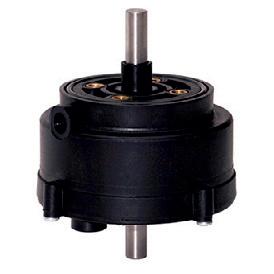

Suitable for the food processing industry, the Flexco line of light-duty belt cleaners can be used from the time the food is harvested to the finished product. As is true with the two other cleaners in the Flexco light duty line-up — the FGP Food Grade Primary Cleaner and FGS Food Grade Secondary Cleaner — the FGP-ES does not need to be disassembled for cleaning, sanitising and changing of the blades because of the snap-inplace design of the blades. Cleaner blades are made with FDA-compliant, food-grade UHMW and are available in white, blue and metal detectable blue; and for uneven or soft-cover belts, blue metal detectable dual durometer.
The cleaners feature a small footprint and come with a complete hardware set, including side plates and standoffs, so installation in any area of the conveyor is fast and easy. They can also be mounted to the service or operations side of the belt for easy access. Exposed components make visual inspections and maintenance easier on the FGP-ES due to easy tensioning that is designed to minimise blade wear and maximise cleanability.
The FGP-ES can be used on any light-duty belt from 304 to 1219 mm and is suitable for use in protein, industrial baking, confectionery, fruit and vegetable processing, and in any other application with stringent sanitation standards.

Flexco Australia



www.flexco.com

Over the last 160 years, Heineken, a Dutch multinational brewer, has established itself as a leading lager company, serving over 25 million servings of the flagship Heineken brand across 192 countries daily.
The brewer has launched its two-year evergreen strategy, focused on shaping the future of beer and beyond. The Stravito enterprise insights platform has been central to this strategy, enabling Heineken to share all of its insights through its internally branded platform, Knowledge & Insight Management (KIM).
Louise Fitzpatrick, Global CMI Capabilities Manager at Heineken, said, “We see KIM as an integral part of our insights ecosystem, which is made up of a united collection of bestin-class tools and frameworks that help us ensure that every decision leads back to the consumer.”
Heineken operates as a decentralised business, with over 90 operating companies globally. The Amsterdam team provides guidance and access to tools to help local operating companies run more efficiently.

“We’re actually a very decentralised business,” Fitzpatrick said. “We often found that we were speaking different languages and, we in the centre, saw this as being a real pity because people were doing great work but nobody was seeing, sharing or discussing it, and often there was duplication across teams.”
A key objective with KIM was to create one version of truth
and encourage a culture of sharing across an aligned ecosystem. The journey to finding the right platform wasn’t immediate, as the company was seeking out something quick and centred around AI.
“Some of the feedback I'm hearing now, which really inspires me, is from senior directors who would never have used CMI tools. They say to me, ‘KIM is amazing, I logged on and I just couldn’t believe the amount of stuff on there, it’s amazing, kind of like Netflix and I just kept going and going,’” Fitzpatrick said.
Heineken has a number of Innovation Platforms to guide the business and its longer term future.
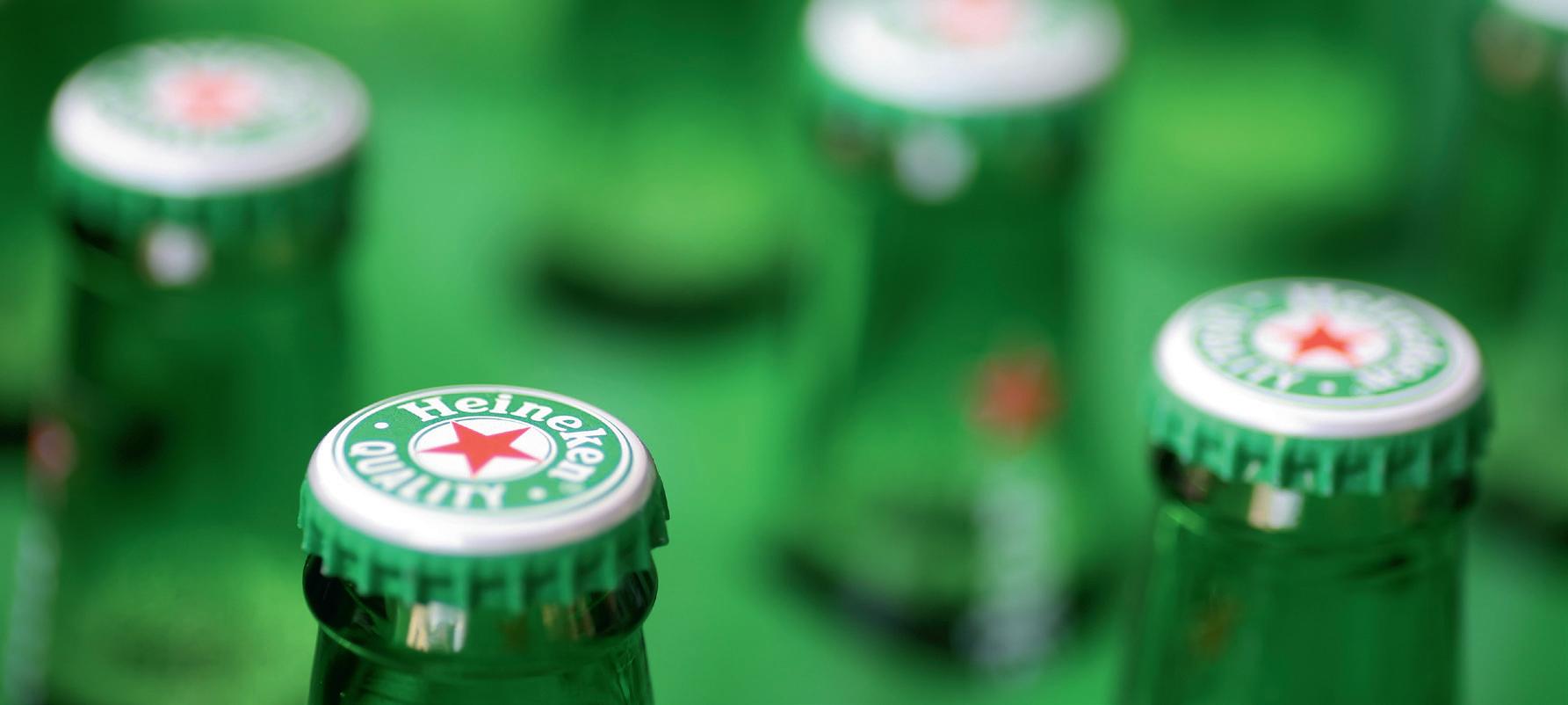
“When creating KIM, we wanted to make our existing research work harder. That meant limiting the amount of research we required,” Fitzpatrick said. “Previously what we would have done is launched a project that aimed to uncover one specific innovation opportunity, involving X amount of focus groups, in X amount of markets, starting from scratch. But, I said to the team, ‘We have KIM. We have so much knowledge here.’”
The team created a project on KIM that it was able to share with its innovation agency, including all of its most recent trend reports, and it ended up that the existing insight was enough and no new research was required, saving money and allowing the process to be completed quickly.

esearchers have come up with a way of speeding up the beer-brewing process with beer-making mini-bots or ‘BeerBots’. Published in ACS Nano , the study shows that these self-propelled, magnetic packages of yeast can make the fermentation phase go faster and cut out the need to filter the beverage.
Beer, one of the world’s most consumed drinks, can take a while to brew. During the first step, sugars are extracted from grains to make a watery solution called wort. Yeasts then ferment those sugars, converting them into alcohol, carbon dioxide gas and new flavour compounds. This step can take up to four weeks and, during that time, unwanted microorganisms can get in and spoil the product with sour flavours.
Previous research has suggested that encapsulating the yeast in polymer capsules could reduce the risk of spoilage by speeding up the process, leading Martin Pumera and colleagues to developing the BeerBots.




The researchers made 2-mm-wide BeerBot capsules by combining active yeast, magnetic iron oxide nanoparticles and sodium alginate from algae and dripping the mixture into a ferric chloride solution. Then they made one side of the spheres porous by exposing that half to an alkaline solution in an electrochemical cell.


Initial experiments showed that the yeast-containing beads could ferment sugar and produce carbon dioxide bubbles that propelled them upward. When they got to the surface, they released carbon dioxide into the air and then sank again, resulting in a bobbing motion. When used to ferment malted barley wort, the team found that the self-propelled BeerBots transformed sugars faster than free yeast cells.
As the sugar was used up and fermentation ceased, the yeast-containing capsules sank to the bottom of the flask. This made it easy to separate the yeast from the final product with a magnet, rather than with a filtration step that’s currently required to remove free yeast cells. Additionally, the collected BeerBots were active for up to three more wort fermentation cycles. The results showed that BeerBots could produce brews faster.
An alternative to a crimp contact is the EPIC ASC axial screw contact from LAPP, designed to enable more reliable assembly using a cost-effective tool.

When crimping, the stripped cables or cores are normally inserted into the sleeves or connectors and pressed together using a crimping tool. The EPIC ASC axial screw contact for the inserts and modules of EPIC connectors instead enables simple screw attachment. The axial screw contact, which can be rotated freely in the high-current module, simplifies assembly, prevents torsional stress and thus provides contact safety between the contact and the cable.

Due to assembly outside the module, fitters can also tell immediately whether the connection has been screwed incorrectly. This prevents errors or failures that could be caused by insufficient coverage between contact and core. The EPIC ASC axial screw contact also features a silver-plated contact surface for low contact resistance and minimum generation of heat at the contact. Touch protection also provides users with maximum protection when connecting and pulling out the high-current module. For conductor cross-sections of 35 to 75 mm2, only an axial screw contact is required; for the connection an inner hexagonal spanner and a fork wrench are sufficient.
Treotham Automation Pty Ltd
www.treotham.com.au
Adiona Tech, a Sydney based startup backed by KPMG, Telstra and PepsiCo, has announced a partnership with CartonCloud, an Australian cloud-based transport management system (TMS) and warehouse management system (WMS) company.
Suitable for FMCG and logistics businesses, the Adiona Tech route planning service has now been integrated into the TMS, allowing for optimised last-mile delivery, and reduced delivery costs and vehicle emissions. The solution is aimed at companies trying to digitise operations, fortify supply chains against disruptive events and meet net-zero goals.
Both CartonCloud and Adiona Tech specialise in helping logistics/transport companies pursue digital transformation projects. The partnership enables CartonCloud to offer route planning to users, using AI and Machine Learning to automate the planning of jobs in minutes. This takes into account real-time traffic data, customer service levels and multiple route options, allowing customers to reduce last mile delivery costs and vehicle emissions.
Adiona Tech
www.adionatech.com
CartonCloud
www.cartoncloud.com
The Balluff BVS ID Optical Ident Sensor is designed to read barcodes, 2D codes and DMC codes and make identification tasks more efficient. With SensorApp software, the sensor offers auto set-up and features configuration and monitoring options via any web browser.

The sensor integrates with existing automation and IT systems and features standardised automation and IT interfaces to transmit information to PLC or IT systems.
It provides additional condition monitoring information when integrated into an IO-Link network. By leveraging the power of the IO-Link network, it provides access to vibration, temperature, code quality and operating time that can enhance production processes for improved decision-making and optimisation.
The BVS ID also supports MQTT or REST API protocols, enabling IIoT (Industrial Internet of Things) communication. These communication options allow connection with other devices, facilitating efficient data exchange and driving Industry 4.0 initiatives.
Balluff Pty Ltd
www.balluff.com.au
According to a study published in the Journal of Food Science, sorghum bran, a low-cost by-product of sorghum milling, can enhance the nutritional value of gluten-free bread without compromising its flavour.
Though in demand, gluten-free foods are sometimes deficient in nutrients and lack appealing taste and texture. Gluten-free bread typically replaces wheat flour with refined flour and starches from other sources. Adding dietary fibre to glutenfree bread can lead to a hard texture and more rapid staling.
To find solutions in this area, U.S. Department of Agriculture’s (USDA) Agricultural Research Service (ARS) researchers studied sumac sorghum bran, classified as a brown tannincontaining variety with antioxidant properties and dietary fibre, as a possible substitute for wheat flour in gluten-free bread.
“In our study, we used optimisation models to create a gluten-free bread with enhanced dietary fibre while preserving other desirable bread attributes such as colour, texture and flavour,” said Ryan Ardoin, research food technologist at ARS’s Food Processing and Sensory Quality Research Unit.

“This meant finding the optimal amount of sumac sorghum bran to use in the bread to get the nutritional benefits without comprising taste and texture.”
The researchers conducted taste tests and asked focus groups to rate different breads, with and without the sorghum bran.
“We found that people liked the gluten-free bread that contains 14.2% sumac sorghum bran and would be just as willing to buy this bread,” Ardoin said. “There was no difference in perceived bitterness found between the bread with and without the sorghum bran.”
According to the National Institutes of Health (NIH), about 2 million people in the US have coeliac disease and over 20% of US consumers purchase gluten-free products without a medical reason. There is a demand for gluten-free food options that have a similar flavour and texture as glutencontaining counterparts.
“The potential health benefits provided by tannin-containing sorghum bran in gluten-free foods can benefit consumers who must avoid gluten as well as those seeking other food options,” Ardoin said.
Australian-based natural flavour and specialised ingredient company Flavorjen has a range of natural dairy flavours, applications technology, specialised ingredients and natural preservatives.

To meet the increasing demand for non-dairy, allergen-free, sustainable products, Flavorjen has a range of vegan flavours. The vegan flavours have been created to help make the finished product maintain a wellrounded, rich flavour while delivering a desirable texture and mouthfeel. The flavours can also assist in masking undesirable flavours, which can be associated with alternative food. The range includes cheese flavours, starter distillates, meat flavours, milk and butter flavours.
The company’s range of vegan and allergen-free dairy flavours can be incorporated several ways into an application, and bring different functionalities. They can be used to create dairy flavours such as cheese, milk and butter; enhance flavour profile; create the mouthfeel; mask bitter flavours; and remove allergens from production.
Applications include: vegan cheese, meat substitute, plant-based milk and allergen-free products.
Flavorjen Pty Ltd
www.flavorjen.com
Allied Pinnacle has announced exclusively licensed patents for High Fibre Wheat in Australia.

The Australian partnership is with Arista Cereals, a joint venture between CSIRO and French farmer-led cooperative Limagrain.
High Fibre Wheat is a natural grown wheat developed and farmed in Australia. It is high in amylose, meaning the resulting flour contains six times more fibre than standard wheat flour without compromising taste or texture. It is set to enter the Australian market in 2023, available exclusively through Allied Pinnacle.

The result of 20 years of global research and development, the wheat is currently grown by wheat farmers across Australia. The naturally higher fibre content is delivered through conventional breeding to provide a more resistant starch, a prebiotic fibre that contains a host of benefits.
HEMCO’s 24800 vented hood workstation features a moulded, seamless construction, including rear and side walls to minimise cross drafts in the work area. Dimensions are 24 ″ wide x 15″ deep x 35″ high.
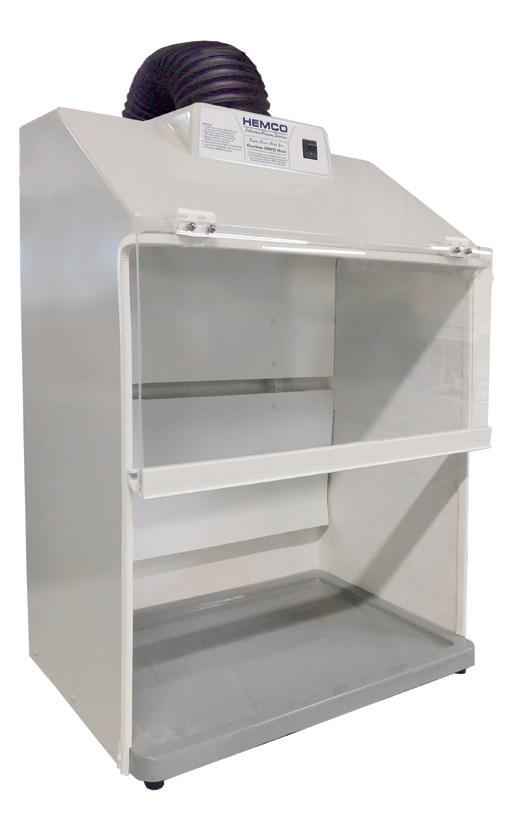
Typical uses include histology, microprocessor, venting for hotplates, microscope stations, student workstations, sample weighing stations and handling pharmaceuticals.
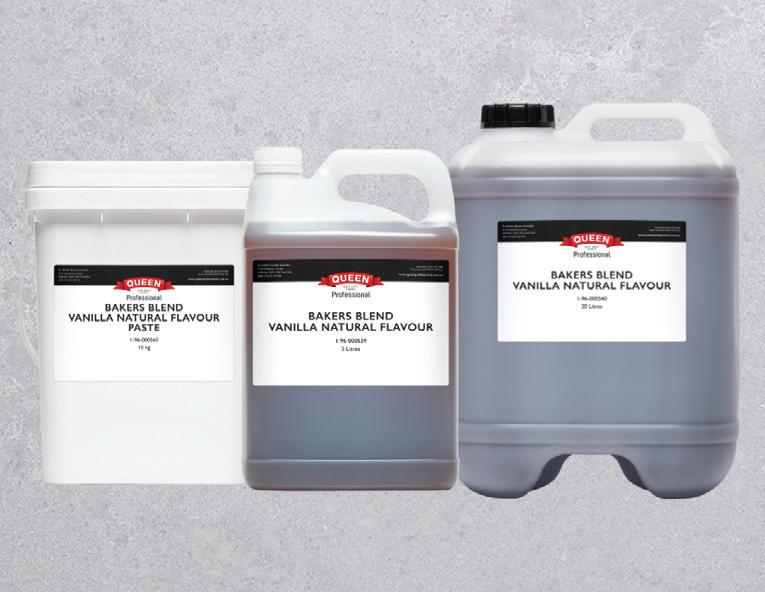
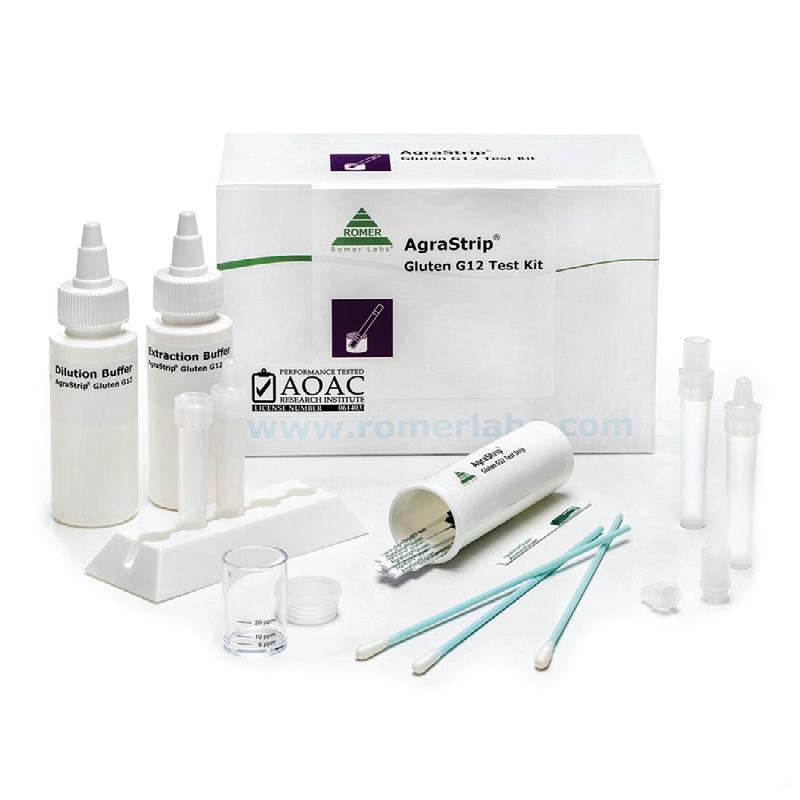
Constructed of chemical-resistant, lightweight advanced composites, it can be easily moved as procedures or workflow change. The moulded chemical-resistant work surface is recessed to contain spillage, and a 3 ″ diameter outlet collar is provided for duct connection. The unit’s base consists of an integral recessed work surface to contain spillage.
HEMCO Corporation
www.hemcocorp.com
Queen Professional has launched a Vanilla Natural Flavour and Paste for industrial manufacturers. The range is alcohol free, gluten free and vegan suitable. This natural flavour range is suitable for dairy, bakery and no-bake applications.
Dr. Oetkar Queen Australia Pty Ltd
www.queenprofessional.com.au

The Pacific Cleaner Shrimp may be the key to keeping white bread white. Due to health concerns surrounding inorganic nanoparticles such as titanium dioxide and zinc oxide, which are traditionally used as whitening agents, there is a search to find organic, biocompatible analogues as a replacement. Dr Ben Palmer and student Tali Lemcoff at Ben-Gurion University of the Negev have discovered a material in cleaner shrimp that produces a white reflector in nature. By studying the white material found in cleaner shrimp, the researchers discovered a completely new principle in optics. The findings were published in the Nature Photonics journal.
The Pacific Cleaner Shrimp, which may otherwise be known as Jacques from Finding Nemo , uses white stripes on its cuticle and appendages to attract fish, which it then cleans by eating parasites off the fish’s body. The researchers looked into the white stripes and found that they were made of an ultra-thin layer of densely packed particles of a small molecule, isoxanthopterin. While making white materials from thick materials is easy, it is more challenging to use thin materials due to optical crowding, where reflectance decreases at higher packing densities. Despite being less than 5 microns thick, the whiteness produced by the shrimp is extremely
bright, making it one of the thinnest and most efficient white materials that exist.
The arrangement of molecules in the particles is the key to the optics. They are arranged in a ‘liquid crystal’, stacked in columns which radiate from the centre of the nanospheres like the spokes of a wheel.
“At first, I thought it was not interesting because the nanospheres were not classic crystals. However, when we looked closer using cryo-SEM and TEM microscopes, we realised not only that the particles are liquid crystals, like those in LCD displays, but that they exhibit birefringence (dual refraction), which is exceedingly rare in the animal world,” Lemcoff said.
This arrangement of molecules is key to overcoming the optical crowding hurdle, allowing particles to be densely packed and reducing the thickness of the layer required to produce bright whiteness.
“It is really one of the first times we have learned an entirely new principle from studying an organism. The shrimp has overcome a seemingly fundamental hurdle in optics by creating particles with this special arrangement of molecules. Now the question is, how can we replicate this effect for creating new materials we could use as food additives in white bread, or in white paint and other applications?” Palmer said.
Twisties has collaborated with Donut King to create a flavour plot twist — Twisties Donut King Cinnamon Donut. The Twisties will be available on shelf for a limited time from 7 August.

www.smiths.com.au/brands/twisties
Menz’s Violet Crumble has announced a 'biggerthan-ever' 280 g bag of its Violet Crumble Bites just in time for World Chocolate Day. The bag will retail nationally from mid-August.

www.menz.com.au
Nestlé Professional has relaunched its aesthetic and contemporary Buondi coffee range in Australia, created specifically for Australian coffee drinkers.

www.nestleprofessional.com.au/
Proper Crisps has introduced two additions to its range: Sweets & Beets and Garden Medley. Sweets & Beets is a blend of seasonal sweet potato and beetroot, with a light sprinkle of sea salt. Garden Medley is crafted with a blend of Chioggia beetroot, sweet carrot, parsnip and sweet potato. www.propercrisps.com/aus-home


SimpliiGood by AlgaeCore Technologies has released a breaded chicken cutlet analogue composed primarily of the microalgae spirulina. This plant-based version is designed to take on the appearance, flavour and structure of real chicken breast and possess a naturally dense nutritional profile. simpliigood.com/
To celebrate Menz FruChocs’ 75th anniversary this year, the legacy South Australian confectionery brand is releasing vintage-inspired packaging available in stores from mid-July.

www.menz.com.au
Westwick-Farrow Media
A.B.N. 22 152 305 336
www.wfmedia.com.au
Head Office Unit 7, 6-8 Byfield Street, North Ryde Locked Bag 2226, North Ryde BC NSW 1670
Ph: +61 2 9168 2500
Editor: Carolyn Jackson wnift@wfmedia.com.au
Editorial Assistant: Vanessa Boumelhem
Acting Publishing Director/MD: Janice Williams
Art Director/Production Manager: Julie Wright
Art/Production: Linda Klobusiak, Marija Tutkovska
Circulation: Dianna Alberry circulation@wfmedia.com.au
Copy Control: Mitchie Mullins copy@wfmedia.com.au
Advertising Sales Manager
Kerrie Robinson
Ph: 0400 886 311 krobinson@wfmedia.com.au
If you have any queries regarding our privacy policy please email privacy@wfmedia.com.au
Printed and bound by Bluestar Print Print Post Approved PP100007395 ISSN No. 1039-8414
NOTICE:
All material published in this magazine is published in good faith and every care is taken to accurately relay information provided to us. Readers are advised by the publishers to ensure that all necessary safety devices and precautions are installed and safe working procedures adopted before the use of any equipment found or purchased through the information we provide. Further, all performance criteria was provided by the representative company concerned and any dispute should be referred to them. Information indicating that products are made in Australia or New Zealand is supplied by the source company. Westwick-Farrow Pty Ltd does not quantify the amount of local content or the accuracy of the statement made by the source.
twist on Twisties, the Garden Medley of veggie chips and a breaded chicken cutlet analogue have all hit the shelves over winter.Image credit: Nimrod Genisher

At IMCD Food & Nutrition, we believe every challenge becomes an opportunity to innovate when you look at it the right way. With over two decades of experience as a leading global distributor and formulator, we help brands anticipate and respond to trends that are making waves in their industry.
Let these four megatrends inspire your discovery in 2023!
• Generation Health
• Growing Greener
• Clean Label Goes Global
• A Feast for the Senses




